

Spring 2024 The Official Magazine of the American Association of Private Lenders COMPLIANCE Investors Squeezing Single-Home Market? Page 6 MARKET TRENDS Capital Market Strategies Page 42 FUNDAMENTALS Building a Powerhouse Team Page 10 Right Place, Right Time LENDER LIMELIGHT
JOBS BOARD! Check out AAPL's Jobs Board Info on Page 5 NEW
Featuring Melissa Martorella
We are dedicated to helping our customers build wealth through real estate. By securing the right financial solution on each real estate investment in their portfolio, ResCap Borrowers have more control over their funds and their future.

ResidentialCapitalPartners.com
T: 866-441-0223
Scan me!



SPRING 2024 3 CONTENTS 06 ADVOCACY Is Predatory Investing Creating a Single-Family Home Shortage? 10 FUNDAMENTALS 10 Your People Are Your Power 16 Maximize Your Mortgage Broker Relationships 20 Instill Confidence With High-Petrformance Loan Servicing 24 Do You Really Know Your Cost Per Loan? 28 MARKET TRENDS 28 State of the Private Lending Industry: Reflecting on 2023 with an Eye Toward 2024 36 2024 Real Estate Investor Activity: Bull or Bust? 42 Ebb and Flow of Private Lender Capital Strategies 50 LENDER LIMELIGHT Right Place, Right Time with Melissa Martorella 58 FUND MANAGEMENT 2024 Market Update: Vintage Is In 62 CASE STUDY 62 Distressed Property Undergoes Impressive Rehab for Section 8 64 Operational Procedures for a Foreclosure 66 Land Value Creates Build-and-Flip Opportunity 68 OPERATIONS 68 Release Operational Pressure by Breaking Bottlenecks 76 Mastering Back-Office Operations in Private Equity 80 A Self-Servicing Portfolio Model 88 Leverage Virtual Employees for Flexibility and Efficiency 92 Comp Selection: Compliant Does Not Mean Good! 96 VENDOR GUIDE 98 LAST CALL Necessity Truly Is the Mother of Invention 6 10 42 SPRING 2024


OUR SERVICES
CORPORATE & SECURITIES
• Securities Offerings and Compliance
LAW FIRM & CONFERENCES
Geraci LLP is a full-service law firm and conference line specializing in representing non-conventional lenders.
(949) 379-2600
90 Discovery Irvine, CA 92618
https://geracilawfirm.com/
https://geracicon.com/
https://geracilawfirm.com/originate-report/
• Entity Formation
• Corporate (Governance, M&A, Capital Markets)
• Mortgage Licensing
LITIGATION & BANKRUPTCY
• Judicial Foreclosure
• General Business Litigation (Partnership, Investor, and Vendor Disputes)
• Creditor Representation in Bankruptcy
• Other Mortgage Loan Litigation
BANKING & FINANCE
• Foreclosure/Loss Mitigation
• Nationwide Loan Documents
• Nationwide Lending Compliance
OTHER SERVICES
• Conference Line
• Originate Report Magazine
• Lender Lounge Podcast
4 PRIVATE LENDER BY AAPL
CONNECT WITH US WE PROVIDE PEACE OF MIND
New Industry Jobs Board Launches

Despite the transition private lending has been experiencing, it’s gratifying to see that our industry has matured and even grown, proving its staying power and role in filling an essential gap among more traditional financial services.
As new private lenders enter the space and established businesses grow, where do they find the personnel to underpin that growth? Mentoring fresh faces is one way, but where and how do you connect with more established professionals?
Relevant side note: One of the ongoing complaints we hear is, “So-And-So hired my best employee! That’s got to be a Code of Ethics Violation!”
[Note: It is not. We do recommend taking operational steps to protect trade secrets and employee noncompetes where warranted and legal.]
When the only way to hire from within the industry is to headhunt and casually put out feelers at events (“So, are you happy at XYZ Company?”), almost any new hire can become fraught with drama.
There must be a better way.
Oh wait! There is!
We are thrilled to announce the launch of the AAPL Jobs Board at aaplonline.com/jobs. AAPL members may list unlimited jobs at no cost, with a nominal fee for job posts from nonmembers. Employers can also choose to take applications through the Jobs Board platform or link to an external service.
Current professionals now have one place to look for positions related to private lending or associated industry vendors.
Although this new service grew from frequent member requests (We heard you and finally built a “thing”!), its success is measured through activity. So please, post and peruse away! Oh, and back to hiring fresh faces or seasoned professionals: William Tessar wrote a well-timed article we’d like to highlight. Check out “Your People are Your Power” on page 10.

SPRING 2024 5
HYDE President, AAPL
HUNGERFORD Executive Editor
RODRIGUEZ Design CONTRIBUTORS
Bean
Chavez
Esq.
LINDA
KAT
DAVID
Katie
Erik Brown Alex Buriak Henry
Vinny Ciardullo Nema Daghbandan,
Daren Blomquist Evan Brody Bill Fairman
Michael Fogliano
Anthony F. Geraci Dana Georgiou
COVER PHOTOGRAPHY
Trujillo Private Lender is published quarterly by the American Association of Private Lenders (AAPL). AAPL is not responsible for opinions or information presented as fact by authors or advertisers. SUBSCRIPTIONS Visit aaplonline.com/subscribe. BACK ISSUES Visit aaplonline.com/magazine-archive, email PrivateLender@aaplonline.com, or call 913-888-1250. For article reprints or permission to use Private Lender content including text, photos, illustrations, and logos: E-mail PrivateLender@aaplonline.com or call 913-888-1250. Use of Private Lender content without the express permission of the American Association of Private Lenders is prohibited. www.aaplonline.com Copyright © 2024 American Association of Private Lenders. All rights reserved.
Benn Jackson Adonis Lockett Diana Luoma Rodney Mollen Sean Morgan Chris Ragland William J. Tessar Scott Ward
Elizabeth
President, American Association of Private Lenders CORNER OFFICE
Is Predatory Investing Creating a Single-Family Home Shortage?
The shortage of U.S. single-family homes is a multifaceted issue requiring a comprehensive and collaborative approach.
BILL FAIRMAN, CAROLINA CAPITAL

Stop predatory investing and end hedge fund control of American homes!
Sounds like a righteous cause, doesn’t it? Stopping large institutional investors from swooping in and buying up all the single-family home inventory, pushing out homeowners in favor of renters, while would-be homeowners cannot compete with an all-cash purchase, resulting in the soaring prices of single-family homes.
That’s the issue Senate bills S.2224 and S.3673 as well as House bill H.R.6608 try to fix. Unfortunately, they don’t address the actual issue and instead blame easy targets, Wall Street, and its accredited investor class. Although the target is the large institutional investors, in the text, these bills can trickle down to the mom-and-pop investors who are just trying to run small family businesses with 50 or more homes.
Let’s start with the myth that all the inventory of single-family homes are being gobbled up by institutional investors.
According to a Freddie Mac chart
published in a December 10, 2023, Housing Wire article by Logan Mohtashami, those who bought more than 100 homes in a 12-month period did not even reach a
2.5% market share going back to the year 2000. In fact, through second quarter 2023, only 1,959 homes were purchased by investors that own more than 1,000 homes. That is 0.03% of the market. The highest percentage of market share, at 19.6%, went to investors who own between one and nine properties. The vast majority of those folks are not cash buyers and would have to compete with would-be homeowners to get loans.
SCARCITY OF SINGLE-FAMILY HOMES
There are several reasons for the high prices. No. 1 is supply and demand, but it’s not because investors are buying up all the inventory. Builders have not been keeping up with new household formations.
Let’s take a deeper dive as to why.
Zoning Regulations and Land Use Policies. One significant factor contributing to the scarcity of single-family homes is the web of zoning regulations and landuse policies. Many municipalities have implemented restrictive zoning codes that prioritize high-density developments or commercial spaces, limiting the availability of land for single-family home construction. Stringent regulations often
create barriers, making it challenging for developers to secure permits for new single-family housing projects.
The NIMBYism (not in my backyard) Mentality. Prevalent in many communities across the United States, NIMBYism poses a substantial hurdle to the construction of single-family homes. Residents often resist new developments in their neighborhoods, fearing changes in property values, increased traffic, and strain on local resources. This resistance, though well-intentioned, contributes to the scarcity of available land and stifles efforts to address the growing demand for single-family homes.
Rising Construction Costs. The escalating costs of construction materials and labor play a crucial role in hindering the construction of single-family homes. From lumber and steel to skilled labor, the expense of building a home has risen significantly, causing developers to reconsider or scale back their projects. The affordability crisis has made it difficult for many families to enter the housing market, exacerbating the shortage.
Infrastructure Challenges. Insufficient infrastructure, such as roads, utilities, and public services, can impede the
6 PRIVATE LENDER BY AAPL ADVOCACY

construction of new single-family homes. Developing infrastructure to support residential areas is a costly and time-consuming process, deterring developers from investing in regions lacking the necessary amenities. Governments at various levels need to prioritize infrastructure development to encourage and accommodate the construction of single-family homes.
Strong Demand Outpacing Supply. One of the primary drivers of the shortage of existing single-family homes for sale is the robust demand from homebuyers. Favorable economic conditions, historically low interest rates, and a growing population have combined to create a surge in demand for housing from 2017 through 2022. Unfortunately, the supply of existing single-family homes has struggled to keep
pace, resulting in a highly competitive market with limited inventory.
Demographic shifts, such as the aging baby boomer population and millennials entering the homebuying market, have further intensified the demand for single-family homes. Baby boomers are often reluctant to sell their homes, contributing to a scarcity of available properties. Meanwhile, millennials, the largest generation in the United States, are actively seeking homeownership, putting additional pressure on the limited supply of existing single-family homes.
Homeowners Opting to Stay Put.
Economic uncertainty, coupled with high interest rates, has led many existing homeowners to choose remodeling or renovating their current homes instead of selling. This trend, known as “aging in place,” has resulted in fewer existing
single-family homes being listed for sale, as homeowners opt to improve their current living spaces rather than navigating the challenging process of selling and buying a new property.
Low Housing Turnover. The historical trend of homeowners moving less frequently than in previous decades has contributed to a lower housing turnover rate. Homeowners are increasingly choosing to stay in their homes for more extended periods, reducing the number of existing single-family homes available for sale. This trend is influenced by various factors already mentioned.
For comparison, 20 years ago the average home turnover was seven years; starting around 2008, it began increasing to a little over 10 years.
SPRING 2024 7
THE RISE IN SINGLE-FAMILY HOME RENTALS OVER OWNERSHIP
Let’s discuss the elephant in the room: If there was not a demand for rental houses, investors would not buy them, especially now at historically high price to rental ratios. (See tradingeconomics. com/united-states/price-to-rent-ratio.) The price-to-rent ratio in the United States measures the nominal house price index divided by the housing rent price index.
This shift in preference reflects evolving attitudes toward housing, shaped by a combination of economic, lifestyle, and demographic factors.
One of the primary drivers behind the surge in single-family home rentals is the desire for financial flexibility. Renting allows individuals to avoid the significant upfront costs associated with purchasing a home, such as a down payment, closing costs, and ongoing maintenance expenses. Renters can allocate their financial resources more freely, adapting to changing circumstances without being tied down by the financial commitments that come with homeownership.
Demographic shifts, particularly among younger generations, play a crucial role in the rising preference for renting single-family homes. Millennials, in particular, value mobility, career flexibility, and the ability to explore different living arrangements. As this generation postpones major life milestones such as marriage and starting a family, the appeal of renting over owning becomes more pronounced, aligning with their dynamic and fast-paced lifestyles.
Economic uncertainties, exacerbated by events like the 2008 financial crisis and the recent global pandemic, have left a lasting impact on individuals’

perceptions of financial security. Some people are wary of committing to a mortgage, preferring the flexibility and reduced financial risk that comes with renting. The ability to adapt to economic fluctuations without being tethered to a long-term mortgage commitment is an attractive prospect for those cautious about the housing market’s unpredictability.
Renting single-family homes provides individuals with the opportunity to live in desirable neighborhoods without the substantial financial investment required for homeownership. In cities with soaring real estate prices, renting allows residents to enjoy the amenities and lifestyle of sought-after areas without the burden of a mortgage. This increased flexibility aligns with the modern preference for experiences over ownership.
MULTIFACETED APPROACH NEEDED
The shortage of single-family homes in the United States is a multifaceted
issue that requires a comprehensive and collaborative approach. Addressing zoning regulations, tackling NIMBYism, and mitigating economic uncertainties are crucial steps in fostering an environment conducive to the construction of singlefamily homes. By overcoming these challenges, policymakers, developers, and communities can work together to ensure there is an adequate supply of housing to meet the needs of new families and promote sustainable growth in the housing market.
What is misguided about these bills is if the government forced institutional investors to sell every investment home they owned, it would only add 700,000 units of inventory—and we are 6 million homes behind new household formations in this country (see Realtor. com/research/us-housing-supply-gapmarch-2023). Forcing sales to homeowners will not address underlying affordable housing or inventory issues for the following reason: The immediate impact
8 PRIVATE LENDER BY AAPL ADVOCACY
of the bills is to forcibly displace less financially secure renting tenants in favor of prospective homeowners.
Even an immediate influx of institutional investment homes on the market will only temporarily impact owned housing supply/demand. It does nothing to close the real gap in the amount of sustained new construction needed.
The way to fix this is not by limiting or controlling who can have what; only by creating a greater supply of single-family homes will this problem be solved.
In 2008, the housing bubble burst because anyone with a pulse could qualify for a loan on a home. That problem has been fixed. It is now time
to address the under-supply of new homes, but not by artificially limiting the competition of who can buy homes.
Regarding the Senate and House bills currently pending: They are not likely to go any further, based on conversations with staffers of senators serving on the Finance and the Banking, Housing, and Urban Affairs committees.
Rest assured, AAPL is constantly monitoring all potential legislation that affects the private lending industry. We work diligently to pass that information along to you and to speak on your behalf to the stakeholders at the local, state, and federal levels.
BILL FAIRMAN

Bill Fairman is a best-selling author, national speaker, and serial entrepreneur who’s been in the mortgage banking industry for more than 30 years. The co-founder of Carolina Capital, he has worked with hundreds of highnet-worth clients to grow their wealth in his more than 10 years as a fund manager. Fairman is a member of AAPL‘s Government Relations Committee.

SPRING 2024 9
EXPERIENCE MAKES ALL THE DIFFERENCE DIRECT SHORT-TERM COMMERCIAL BRIDGE LOANS redoakcapitalholdings.com 4 Lending Programs Ranging from $1-20M Nationwide: Primary, Secondary, and Select Tertiary Markets

Your People Are Your Power
Three keys—experience level of originators, compensation, and office structure— empower you to build a powerhouse private lending team.
WILLIAM J. TESSAR, CV3 FINANCIAL SERVICES

n the world of private lending, success is often synonymous with the strength and cohesion of your team. The choices you make regarding the experience level of originators, your compensation models, and the structure of your office environment (i.e., inoffice/remote/hybrid) can significantly impact your team’s performance.
Let’s dive into how each one provides an opportunity to create a powerhouse private lender team.
THE EXPERIENCE DILEMMA: NEW TALENT VS. SEASONED PROFESSIONALS
Originators are the “hunters” of any lending organization. They bear the responsibility of finding, building, and nurturing client relationships to generate revenue. The pressure can mount, because the success of a lender often hinges on the originators. Originators also play a crucial role in assessing risks and structuring deals that align with the needs and objectives of the organization.
When it comes to building an origination team, you have many factors to consider. One is whether to hire new originators or experienced ones. There are advantages and considerations associated with both approaches.
It can be said that all originators should focus on two things: building a database with new customers and nurturing that database once they’ve built it. If you believe this to be true, you likely subscribe to the idea of hiring an
10 PRIVATE LENDER BY AAPL FUNDAMENTALS

experienced originator who already has an existing book of business; however, there is a strong argument to be made for hiring high-quality individuals, even those with little-to-no experience, and teaching them your best practices.
Embracing the Fresh Perspective of New Originators. Welcoming new originators into your private lender team injects a burst of innovation and fresh perspectives. These motivated professionals often come with creative solutions and the enthusiasm to tackle challenges in novel ways. Their adaptability to technology and willingness to learn can be assets in an industry that is rapidly changing, and there is something powerful to be said for starting fresh and not having to “unlearn” old ways of doing things. However, the cost of hiring and training new talent shouldn’t overshadow the value they bring to the table.
Today in lending it is rare for companies to invest in building tomorrow’s origination
professionals, but there is much truth to be had for the return on investment for developing new talent in-house. With the proper dedication of time and resources, including mentorship pairing, you can teach a rewarding career in lending and real estate. Investing in a training program ensures that the originators’ potential is maximized, allowing them to grow into valuable assets for your organization.
Leveraging the Wisdom of Seasoned Originators. On the flip side, experienced originators bring a wealth of industry knowledge and expertise. Having navigated various market conditions, they understand the intricacies of deal structuring, risk assessment, and market trends. Their established networks can open doors to new opportunities and enhance your private lending operation’s credibility.
Although experienced professionals may command higher salaries, the reduced learning curve and immediate impact they
can make on your team’s performance often justifies the investment. Striking a balance between new talent and seasoned professionals can create a well-rounded and powerful origination team.
Finding the Right Balance. Ideally, origination teams include both new and experienced originators. This balance ensures the team benefits from the innovation and cost-effectiveness of new talent while capitalizing on the industry knowledge and networks experienced professionals bring to the table.
COMPENSATION: NAVIGATING REV SHARE VS. BPS ON VOLUME
Whether your originators are seasoned or green, your compensation structures play a pivotal role in shaping the foundation of your team. Two prevalent compensation models in the private lending industry are
SPRING 2024 11
“
THE CHOICE BETWEEN REVENUE SHARING AND BASIS POINTS ULTIMATELY DEPENDS ON THE GOALS, CULTURE, AND LONG-TERM STRATEGY OF YOUR COMPANY.
revenue sharing (rev share) and basis points (BPS) on volume.
Revenue sharing. Revenue sharing fosters a collaborative environment where the success of the team is directly tied to the success of the company. This is a collaborative approach in which originators receive a percentage of the revenue generated from the deals they bring in, creating a shared
incentive to drive overall business growth. Rev share models inherently mitigate risks by aligning the interests of originators with the long-term success of the lending institution.
Since their compensation is tied to the performance of the deals they originate, originators are motivated to prioritize quality over quantity and to ensure the sustainability of the loans they bring in.
That being said, the capital structure needs to be one of shared ownership in which everyone believes they are building shared value. The downside risk for the originator in a rev share model is that although they make contributions to the company, there could be other items within the

12 PRIVATE LENDER BY AAPL
FUNDAMENTALS
company (unrelated to their day-to-day responsibilities) that result in loss, and that loss negatively impacts their comp.
In a true rev share model, there should be connectivity from a profit-and-loss perspective that aligns the company with the originator, including but not limited to:
Direct and indirect loan level costs.
Loan loss associated with default.
Gain on sale associated with loan sales.
Some form of allocated overhead.
By linking compensation to the overall revenue and profitability generated by the team, rev share models promote a sense of unity and collaboration among
team members. With this team cohesion, originators are more likely to share knowledge, support one another, and work toward collective success, ultimately benefiting the entire lending operation.
Considering Basis Points on Volume. With basis points on loan volume, originators earn fixed (or variable) basis points for each dollar of loan volume they generate, creating a direct correlation between results and compensation, and providing a clear incentive for originators to focus on closing deals and increasing loan volume. This model is both flexible and scalable, making it highly appealing to most private lenders. It allows lenders to adjust compensation structures based on

Secure
market conditions, ensuring adaptability to changing business landscapes.
Vastly different from the collaborative approach of rev share, BPS on volume has a much greater focus on individual origination performance. As loan volumes increase, originators can see their compensation grow proportionally. Originators are driven to maximize their personal loan production, which can lead to healthy competition within the team. However, striking a balance between individual achievement and collective success is essential to maintain a cooperative team culture.
Choosing the Best Fit. The choice between revenue sharing and basis points

SPRING 2024 13
Improve Loan Management While Reducing Portfolio Risk.
Manage draws and disbursements
Schedule inspections with ease
payments to Subcontractors
waiver
Digital lien
sign & store www.Sekady.com

ultimately depends on the goals, culture, and long-term strategy of your company. By carefully considering the strengths and potential pitfalls of each approach, you can tailor compensation structures that drive success, enhance team dynamics, and contribute to the sustainable growth of your lending operation.
IN-OFFICE COLLABORATION VS. REMOTE FLEXIBILITY
All organizations today face a new logistical decision: Where will our team members
“
THE SYNERGY OF MINDS CONVERGING IN ONE ROOM OFTEN SPARKS A CREATIVE COMBUSTION THAT GIVES RISE TO SOME OF THE MOST INNOVATIVE IDEAS. "
14 PRIVATE LENDER BY AAPL
FUNDAMENTALS

work? The choice between maintaining an in-office team structure or embracing the flexibility of remote work has become a dilemma for many private lenders.
The In-Office Allure. The in-office model has long been the hallmark of organizational structures— and for good reason. It fosters an irreplaceable energy through faceto-face collaboration, spontaneous interactions, and a shared sense of camaraderie and company culture. The synergy of minds converging in one room often sparks a creative combustion
that gives rise to some of the most innovative ideas. The physical presence of a team cultivates streamlined communication, team building, and a sense of collective identity, while also providing the invaluable opportunity to maximize performance through direct management and supervision.
Remote Flexibility. On the flip side, the rise of remote work is rewriting the rules of engagement for businesses. Technology has enabled seamless connectivity, allowing teams to collaborate effectively from diverse locations. Embracing remote flexibility opens doors to a broader geographic talent pool, reduces operational costs associated with physical office spaces, and fosters a better work-life balance for employees.
Do take heed, however. A successful remote environment requires mutual trust, which you can help foster through transparent communication, clear expectations, and empowering employees to take ownership of their work.
Hybrid Redefined. As organizations grapple with the decision between inoffice tradition and remote flexibility, a hybrid approach is a popular and compelling solution. Balancing the benefits of face-to-face collaboration with the advantages of remote work, this model can offer the best of both worlds. It can provide the needed work/life balance and flexibility many team members crave while maintaining the collaborative spirit crucial for synchronicity, camaraderie, and a positive, cohesive company culture.
As you navigate the nuanced decisions surrounding hiring the ideal origination team, structuring compensation models, and choosing between in-office vs. remote work, one truth becomes apparent: There is no one-size-fits-all
solution. Each consideration requires a tailored approach to the unique identity and objectives of your organization.
To put it simply, your people are your power . This holds true no matter what domain you operate within and can serve as a bold reminder of the impact your choices have on the quality and talent your organization stands for. By embracing adaptability, fostering a positive culture and work environment, and remaining attentive to the ever-changing landscape of the private lending industry, you can build and sustain an engaged, highperforming, powerhouse team.
WILLIAM J. TESSAR

William J. Tessar is CEO and president of CV3 Financial Services. During his 35 years of mortgage experience, Tessar has founded and served as president of four companies in the mortgage and private lending space, resulting in originations exceeding $40 billion.
With a fierce following of team members, Tessar launched CV3 in 2023 and quickly grew originations to surpass $400 million in the first six months, asserting CV3’s position as a leader in the private lending space.
Tessar was named 2021 AAPL Member Lender of the Year and is a leading voice in the private lending industry.
SPRING 2024 15
Maximize Your Mortgage Broker Relationships
When you implement strategies for nurturing the connections brokers bring to the table, you can unlock a wealth of opportunities for growth, profitability, and industry leadership.
BENN JACKSON, CONSTRUCTIVE CAPITAL

n the realm of private lending, cultivating and managing strong relationships with mortgage brokers is paramount to success. As a private lender, your ability to forge lasting connections with your broker partners not only ensures a steady stream of quality leads and business but also enhances your reputation and credibility in the industry. Understanding the dynamics of these relationships and implementing effective strategies can significantly elevate your business prospects.
This guide delves into the importance of broker relationships, how brokers add value, and specific techniques to cultivate and manage those crucial connections.
THE VALUE OF MORTGAGE BROKERS
Mortgage brokers serve as intermediaries between borrowers and lenders, playing a pivotal role in the loan origination process. Their expertise lies in understanding the diverse needs of borrowers, navigating complex financial landscapes, offering a wider array of loan options than a typical lender could offer directly, and matching clients with suitable lending solutions.
For private lenders, collaborating with brokers offers numerous benefits.
Access to Quality Leads. Brokers have extensive local and national networks and connections within the real estate and financial industries. By partnering with them, private lenders gain access to a steady flow of pre-qualified leads, saving time and resources on prospecting.
Risk Mitigation. Brokers conduct thorough due diligence on borrowers, assessing their financial health, creditworthiness, and loan requirements. This diligent screening process reduces the risk of default and ensures that private lenders fund projects with promising prospects for repayment.
Market Insights. Brokers possess valuable insights into market trends, property values, and borrower preferences. For example, the broker may have in-depth knowledge of select geographies based on their historical and current book of business. Leveraging this expertise, private lenders can make informed decisions regarding loan terms, interest rates, and investment opportunities, thereby maximizing returns and minimizing risks.
Streamlined Process. Working with experienced brokers streamlines the loan origination process, from initial application to closing. Their knowledge of industry regulations, documentation requirements, and underwriting standards facilitates efficient transactions, enhancing overall operational efficiency. This allows private lenders to focus on what they do best, which is closing more loans.
CULTIVATING BROKER RELATIONSHIPS
Building and nurturing strong relationships with mortgage brokers requires a strategic approach and consistent daily effort. Consider these specific techniques to help you cultivate and manage these valuable connections effectively.
Understand the Broker’s Strengths and Goals. Before forging partnerships with mortgage brokers, delve into their strengths, processes, and objectives. Assess their industry network, client acquisition strategies, onboarding approach, and compliance practices to ensure alignment with your organization. Determine whether they prioritize relationships with private lenders and strive for preferred lender status.
Engage in open dialogue to understand their motivations and goals in working with private lenders. By aligning your efforts with their objectives and fostering mutual collaboration, you pave the way for enduring partnerships and mutual success. As you continue to refine your approach to broker relationship management, remember to adapt to changing market dynamics, embrace innovation, and prioritize the needs of your broker partners.
Establish Clear Communication Channels
Open and transparent communication is essential for fostering trust and
16 PRIVATE LENDER BY AAPL
FUNDAMENTALS

collaboration; simply put, be available. Provide brokers with multiple channels to reach you, such as phone, email, and messaging platforms. Be flexible with your time, promptly respond to inquiries, address concerns, and keep them informed
about your lending criteria, product offerings, and guideline updates.
Offer Competitive Loan Products. To attract brokers and their clients, design loan products that are competitive in terms of interest rates, loan-to-value ratios, and
flexibility. Conduct market research to understand prevailing rates and industry standards, and tailor your offerings to meet the needs of various borrower profiles.
Provide Timely Feedback. When brokers submit loan applications or proposals, prioritize timely review and feedback. Respect their time and effort by promptly evaluating submissions, providing constructive feedback, and communicating lending decisions within agreedupon timeframes. Clear and efficient feedback mechanisms demonstrate professionalism and reliability, fostering a positive reputation among brokers.
Offer Educational Resources and Training. Knowledge is power, and by empowering mortgage brokers with comprehensive training and educational resources, you position yourself as a trusted advisor and industry expert. Consider developing an online knowledge base or resource library containing articles, guides, and video tutorials on topics relevant to mortgage brokering and private lending. Cover subjects such as loan structuring, credit analysis, regulatory compliance, and market trends. Furthermore, offer periodic training sessions or workshops led by subject matter experts within your organization. These sessions can delve into advanced topics, case studies, and real-world scenarios, equipping brokers with the tools and insights they need to excel in their profession.
By investing in broker education and professional development, you foster a culture of continuous learning and collaboration, strengthening your relationships and positioning yourself as a thought leader in the industry.
Attend Networking Events. Actively participate in industry events,
SPRING 2024 17
conferences, and networking forums where mortgage brokers congregate. These venues provide opportunities to establish face-to-face connections, exchange business cards, and engage in meaningful discussions. By demonstrating your presence and commitment to the industry, you reinforce your credibility and visibility among brokers. In addition to networking events, your referral network is a tremendous channel for connecting with prospective brokers.
Offer Incentives and Rewards. Recognize and incentivize brokers who consistently bring quality business to your lending institution. Implement referral programs, commission structures, or bonus schemes to reward brokers for their efforts and contributions. By aligning their interests with yours, you encourage long-term partnerships built on mutual benefit and trust.
Seek Feedback and Collaboration. Actively seek feedback from brokers regarding their experiences working with your lending institution. Listen attentively to their suggestions, concerns, and areas for improvement. Strive to incorporate their input into your operations and service offerings. Collaborate with brokers on joint marketing initiatives, co-branded campaigns, or educational events, fostering a sense of ownership and partnership. Finally, on-site visits are an extremely valuable way to interact face-to-face with brokers; try to plan for one or two visits each year.
LEVERAGE TECHNOLOGY FOR RELATIONSHIP MANAGEMENT
In today’s digital age, technology plays a crucial role in streamlining communication and enhancing
collaboration between private lenders and mortgage brokers. Consider adopting customer relationship management (CRM) software tailored to the lending industry. These platforms enable you to centralize broker contacts, track interactions, and automate follow-up tasks. By leveraging CRM tools, you can stay organized, maintain detailed records of broker engagements, and provide personalized service to each broker partner.
Additionally, explore digital platforms and online portals that facilitate loan submissions, manage documents, and provide real-time status updates. Investing in user-friendly, cloud-based systems simplifies the loan origination process, reduces administrative overhead, and improves efficiency for both lenders and brokers. Embracing technology not only enhances operational effectiveness but also demonstrates your commitment to innovation and convenience, making you an attractive partner for tech-savvy brokers.
Maintain Professional Integrity
Uphold the highest standards of professionalism, integrity, and ethics in all your interactions with brokers. Honor commitments, adhere to regulatory guidelines, and prioritize the best interests of borrowers and stakeholders. By consistently demonstrating integrity and reliability, you earn the trust and respect of brokers, paving the way for enduring relationships. Understand there are many options for brokers these days and most lender programs have only slight differences. Integrity, professionalism, and consistency are key differentiating factors for many brokers.
Cultivating and managing relationships with mortgage brokers is both an art and a science. By recognizing the value brokers bring to the table and implementing
effective strategies to nurture these connections, private lenders can unlock a wealth of opportunities for growth, profitability, and industry leadership.
Remember, building strong broker relationships is not just about transactions; it’s about building trust, fostering collaboration, and creating long-lasting partnerships that benefit all parties involved. Embrace these principles, invest in relationship-building efforts, and watch your lending business thrive in today’s competitive landscape.
BENN JACKSON

Benn Jackson serves as the senior director of Wholesale Business Development at Constructive Capital, where his extensive real estate background adds value to the team. Before joining Constructive, Benn held senior roles at CoStar Group and ShowingTime (Zillow), showcasing his knack for sales and software solutions.
Jackson holds a real estate broker license in Illinois and maintains involvement in the real estate industry by operating a handful of rental properties. With a keen eye for investment opportunity, Jackson has completed two successful flips and managed renovation crews through multiple value-add projects.
18 PRIVATE LENDER BY AAPL
FUNDAMENTALS
LEARN. DIFFERENTIATE. GROW.
We now offer our signature Certified Fund Manager and Certified Private Lender Associate courses online, so you can earn your AAPL-backed certified status from the comfort of anywhere — and promote it everywhere.
CPLA Modules
• Intro to Business-Purpose Lending
• Legal Documentation
• Underwriting
• Loan Servicing
• Workouts
• Intro to Securities
CFM Modules
• Pros, Cons, & Considerations
• Structure
• Creation & Launch
• Administration

AAPL Certifications are members-only. Enroll online at aaplonline.com/courses for $349.
Instill Confidence With HighPerformance Loan Servicing
Regardless of your monthly volume, one aspect of lending that matters to all stakeholders in your operations is loan servicing, so vet these vendors carefully.
VINNY CIARDULLO, EASY STREET CAPITAL

oan servicing is more often a cost than a revenue generator, so it’s easy for private lenders to overlook the time and effort that should go into establishing and maintaining sub-servicing relationships. When servicing is neglected, the impact on your business is real; both your borrowers and employees bear the brunt.
Given the high-touch nature of business purpose loans, every contact with your borrower is either an opportunity to instill confidence in your platform or to sow the seeds of doubt that there may be a better ease-of-use option available. So, how does a private lender put the right pillars in place to optimize these touch points and monitor the performance of your servicer?
The simple answer is to start with a tight grasp of your own business capabilities and goals. Don’t look just at the present. What are you designing and executing that will have different requirements down the road?
Finding a servicer that best fits your business is more about understanding your abilities to work with the servicer than the servicer’s ability to perform within

20 PRIVATE LENDER BY AAPL
FUNDAMENTALS
the confines of “generally acceptable servicing practices.” The latter is certainly important and shouldn’t be discounted, but it’s also a conclusion that can be reached with relatively straightforward due diligence and a bit of market research.
The tougher nut to crack is what type of treatment your portfolio will get in the short term and long term as the servicer takes on more loans from you and potentially others. Subsequently, what burden does that leave to be shouldered by your organization to offer your borrowers the best experience possible?
WHAT TO ASK YOURSELF BEFORE ENGAGING A SERVICER
Before you engage a servicer, get clear about your intentions and how a servicer aligns with them. Some questions worth asking before you engage a servicer include:
What’s the strategy for your loans? If the loans are going to be sold, securitized, or financed, ensure your capital partners are comfortable with and will approve your servicing choice. More important for DSCR at this point, but if you are planning on securitizing DSCR loans, take the additional step of ensuring the servicer is satisfactory for rated execution as well.
How long are you going to hold the loans? The answer to this question will determine how quickly you will need to board loans to the servicer. Depending on whether loans are sold servicing released or retained may influence your decision to have the loans boarded at all. If loans are pledged or will be pledged to a financing facility, find a servicer familiar with the monthly remittance
requirements of repo lenders and procedures around depository account control agreements.
What’s the plan for ongoing involvement with the loans after sale? For RTL loans, and in some cases, DSCR, the lender will stay engaged after the sale of the loan and perform servicer oversight or asset management for the loans. If this is important to you as a seller of loans, consider what experience the servicer has with this type of transaction construct. Working with servicers that understand the needs of an asset manager will bolster your ability to better service your customers and keep the loan portfolio moving in a positive direction.
WHAT CAN A SERVICER PROSPECT HANDLE?
Once you’ve established a strategy for the loans, you can look into the capabilities of your counterparties. A logical place to start in these conversations is the servicer’s staffing and organizational structure.
What type of assembly line is in place, and how many people are required to make it function the correct way? Depending on the product and probability of delinquency in the loan portfolio, your expectations around experience and the number of loans that can be managed by a single servicing rep may vary. Additionally, are those reps also responsible for other lenders’ portfolios, and what impact will that have on their ability to service yours?
Another important question to consider is what access will you, as the lender, have to servicing personnel? Some servicers operate a “SPOC” or single-point-ofcontact model. In such cases, no matter the question, all traffic is filtered through
your account owner. This is great for consistency, but it is less effective for turn times related to specific loan-level inquiries because the SPOC is often removed from daily management of loans and acts more as a team lead.
Next, having a communication policy with your servicer is key for the success of the loan portfolio. It’s important to implement a system that creates as little confusion as possible for the borrowers and maintains a quality of contact any time the servicer communicates with the borrower. These scripts help keep the servicing notes up to date and align the servicer with the goals of the lender related to ongoing asset management and data collection. For example, on RTL loans that have a rehab component, any time the servicer is successful in reaching the borrower, it’s an opportunity to solicit updates on the rehab project or potential need for extensions.
Being proactive in the collection of this feedback can avoid chasing borrowers at later stages of their project when the focus should be on completion and the eventual exit of the loan. In assessing whether the servicer is the right fit for your communication needs, it’s also good to understand how the servicer is sending written notices, how quickly the servicer can run updated outreach campaigns, and what the call center or auto-dialer systems look like.
USING TECHNOLOGY
Technology is increasingly important as your portfolio grows. The good news for private lenders is there’s more focus on technology platforms that are used to originate and service business-purpose loans. Unfortunately, it’s still unlikely that you will see a larger-sized servicer using
SPRING 2024 21

servicing technology set up specifically for the management of RTL and DSCR loans.
The more likely scenario is they are using a version of their existing commercial loan servicing platform or 1-4 consumer residential servicing platform that’s been customized to handle the unique features of RTL and DSCR loans. A few areas to focus on, if this is the case, would be accrual of delinquent interest, cross-collateralization, the release of collateral from multiproperty loans, and correct treatment of interest for disbursements of Dutch vs. non-Dutch loans. This list has the potential to be much larger depending on the number of unique loan features offered.
Because the systems being used today to service these loans are not quite fit for purposes outside of the box, it results in calculations and tasks taking place outside of the system. As mentioned before, these gaps need to be filled by the servicer or within your organization. For this reason, ensure that audit procedures around balances and payments are
in place and frequently monitored. The servicer should be performing these audits on top of your own.
As our industry continues to become more institutionalized, there’s a growing need for actionable data. Most conversations that occur on the capital markets front begin with “Send me your performance history.” Being able to produce this data in a digestible format will pay dividends as you seek to introduce new partners to your platform for financing or sale. To make good on these requests, you must have a handle on the data received from the servicer:
What information will the servicer send?
How often will you receive this information?
Most importantly, does your organization have the ability to take this data and make it useful?
The cadence and type of data received will be more similar than not, but the terminology and purpose of specific data items can differ among servicers. As you
interview potential servicing partners, spend more time than you think is needed to get the onboarding completed correctly and the data mapping established. The efforts you put into this upfront will create the tools to monitor the portfolio as well as the performance of your servicer.
When it comes to the lender-servicer relationship, there’s a top for every kettle. The keyword here is relationship. Ask questions that will help focus efforts to serve your borrowers and capital providers and be prepared to fill in the gaps.
VINNY CIARDULLO

Vinny Ciardullo is the head of capital markets at Easy Street Capital. His background includes loan sales, securitizations, debt financing, and process and project management. For the past 10 years, Ciardullo has focused primarily on mortgage and real estate finance.
Prior to Easy Street Capital, Ciardullo was the senior vice president of capital markets for CIVIC Financial Services.
During his time with CIVIC, he managed the sale of more than $4 billion in loans. He also oversaw the use of more than $1 billion in senior secured financing and the execution of two businesspurpose securitizations. Ciardullo began his career in supply chain finance but transitioned to mortgage finance while working for the Royal Bank of Scotland.
22 PRIVATE LENDER BY AAPL
FUNDAMENTALS

BECOME A VALUED CORRESPONDENT LENDING PARTNER INTERESTED IN BECOMING AN APPROVED CORRESPONDENT? Access Financing For... White Labeled Origination Leverage to Scale Your Portfolio Nationwide Reach At RCN Capital, You’ll Experience: Visit RCNCapital.com \ Email CorrespondentLending@RCNCapital.com LONG-TERM RENTAL 30-Years FIX & FLIP 12-Months (Longer Term Options Available) NEW CONSTRUCTION 12 to 24-Months ©RCN CAPITAL, LLC. 2024 ALL RIGHTS RESERVED. NMLS #1045656. RCN CAPITAL, LLC IS LICENSED IN AZ (LICENSE #: 0932325), CA (LOANS MADE OR ARRANGED BY RCN CAPITAL, LLC PURSUANT TO A CALIFORNIA FINANCE LENDERS LAW LICENSE # 60DBO-46258), MN (MN-MO-1045656), AND OR (ML-5571). THIS IS NOT AN OFFER TO LEND. ALL OFFERS OF CREDIT ARE SUBJECT TO DUE DILIGENCE, UNDERWRITING AND APPROVAL. NOT ALL BORROWERS WILL QUALIFY AND NOT ALL BORROWERS THAT QUALIFY WILL RECEIVE THE LOWEST RATE OR BEST TERMS. ACTUAL RATES AND TERMS DEPEND ON A VARIETY OF FACTORS AND ARE SUBJECT TO CHANGE WITHOUT NOTICE.
Do You Really Know Your Cost Per Loan?
Lenders who have a comprehensive understanding of their costs can strategically position themselves in the market and leverage their knowledge to create a better profit margin.
DANA GEORGIOU, FIRE CAPITAL GROUP

In the intricate world of mortgage lending—regardless of forward, reverse, or private lending—understanding the costs associated with producing a loan is crucial. Such knowledge is necessary for mortgage origination companies to maintain or grow profitability and to offer competitive interest rates and fees to borrowers.
Understanding your cost to produce a loan is one area all private lenders should know and understand. However, many
private lenders entering the industry do not have a deep or extensive mortgage background and, therefore, may not know which best practices to use to measure their lending business’ success.
COST FORMULA
Although there are some variations among lenders regarding a standardized formula for determining the cost of a loan, the most widely used is:
Let’s do an example for a period we will call Q4 2024:
The lender shop produced 264 loans for just over $99 million with a gross revenue profit of $2,481,600.
The breakdown of costs based on the previous formula is $868,000 for loan officer compensation, $74,000 for marketing (origination costs) plus $205,000 in processing/underwriter salaries plus $1,500 in compliance/ regulatory costs plus $180,000 in closing/post-closing costs plus $32,000 in capital/carry costs. The total of these costs is $1,360,500.
The easy math here is in calculating profit pretax: Revenue minus costs, which in this exercise nets $1,121,100, which is a healthy profit margin of 45%. But to understand it as a cost per loan, the math needs to take another step. You must divide by the number of loans: Costs = $1,360,500/264 loans = $5,153 to produce each loan in Q4 of 2024.
Inaccurate calculations or not doing this exercise at all prevents you as a lender from intimately knowing your shop and where you are spending the dollars you have worked so hard to earn. Without understanding your cost per loan, how
24 PRIVATE LENDER BY AAPL
LET: EQUAL: Co Origination Cost Cpu Processing/Underwriting Costs Ccr Compliance/Regulatory Costs
cpc Closing/Post-Closing Costs
co Capital/Overhead Costs
Number of loans in a set period C o + C pu + C cr + C cpc + C co N C total = FUNDAMENTALS
C
C
N

will you assess where you have potential cost savings? Or whether you are able to lower your profit margin to lower rates and thereby potentially increase volume?
BREAKING DOWN THE COSTS
Let’s break down each of the cost categories:
1 Origination Costs. Loan officer compensation will usually be the largest cost in this formula. There are different schools of thought about compensating originators, but generally they are calculated based on basis points (BPS) times total loan production or by a percentage
of revenue per loan. Although loan origination compensation will be the largest cost in the origination bucket, marketing/advertising must also be part of the origination cost calculation. These expenses may include things like lead generation services, conferences, or the creation of a website.
2 Processing/Underwriting. There are two components to consider in the processing/underwriting category: personnel costs and technology. Depending on the size of your lending shop, you may not utilize processors; instead, the originator may fill that role. Whatever your model, the total salaries tied to a processor or underwriter
involved in the total loan production should be used. Technology costs would include any tool being used in your production model such as CRMs, LOS, and/or servicing platforms. Depending on the size of your shop, these tools can vary widely, as well as the costs associated with them.
3 Compliance and Regulatory. For the most part, private lending has very few regulatory requirements that have a significant impact on the cost of producing a loan. However, several states require lenders to be licensed. If you are lending in these states, or if you require your originators to be NMLS registered, make sure you
SPRING 2024 25

are including these types of costs in your calculation. An additional, often overlooked, oversight component is quality control. Whether you have an in-house QC group or you are using a vendor to provide this service, don’t forget to group that cost into the compliance and regulatory cost bucket.
4 Closing and Post-Closing. Much like processing and underwriting, this bucket is primarily made up of salaries for any positions supporting the closing and post-closing functions. However, if there are other costs (e.g., legal documents) and you don’t pass those costs through to the consumer, they should be included in your calculation.
5 Capital and Overhead. As a lender, the cash you are using to fund your loan production usually comes with a cost. This cost can vary with the source as well as the time that cash (capital) is being extended. Additionally, depending on the size, type of product you offer, and your overall model,
the cost of capital can wildly vary from lender to lender. While cash is most certainly king, don’t forget to include any general overhead costs. Things like rent, phone systems, etc. are part of the overhead associated with mortgage loan production.
Although what makes up the cost to produce a loan is generally considered to be standard, the actual cost to produce a loan varies. Lenders located in states with lower costs of living may be able to take advantage of lower salaries versus lenders in California, for example.
The dynamic nature of the private lending industry requires lenders to adapt continuously. Understanding costs enables you to identify areas of improvement and implement changes that help you stay competitive and resilient. By understanding the cost of producing a loan, you have a deeper understanding of the profit (or loss) within your shop, which is essential for making informed decisions about the types of loans to offer and the markets to
target or expand to. Lenders who have a strong or comprehensive understanding of their costs can strategically position themselves in the market and potentially leverage this knowledge in their loan products while creating a profit margin.
Consider doing a deep cost analysis of your lending firm if you haven’t already. The results can lead to a quicker, more efficient loan process and/or loan decision. This in turn can bring down the cost of producing a loan and improve the customer experience. Additionally, knowing the cost per loan will help you develop more accurate budgets and forecasts. This facilitates better financial planning and helps in allocating resources efficiently.
Depending on the size of your lending shop, you may want to consider a thirdparty financial consulting company to dig into your costs and evaluate your spending. If you do your review internally, at minimum, using an accounting tool or even a simple Excel spreadsheet will help illustrate your cost to produce a loan.

Dana Georgiou is a mortgage professional with nearly 30 years of mortgage lending experience, including senior/executive management roles in sales, marketing, and lending operations. She has a deep background in mortgage consulting and has worked in all channels of the mortgage business. Georgiou is an avid speaker and a staunch advocate for education in the mortgage lending space.
26 PRIVATE LENDER BY AAPL
FUNDAMENTALS
DANA GEORGIOU

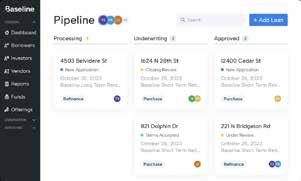



SPRING 2024 27 Streamline Your Private Real Estate Lending Business All your private lending operations in one place. Discover more at www.BaselineSoftware.com Eliminate point solutions Connect your entire ecosystem Create quotes, manage documents & more. Speed to close. Power to scale Offering a simpler, more reliable, and faster way for real estate investors to access financing for investment properties. • Fix and Flip / Bridge Loans • New Construction / Infill Loans • DSCR Single Asset Rental Loans • Rental Portfolio Loans • Cash-Out Refinance Loans Visit kiavi.com NMLS ID 1125207 NREIG provides customizable insurance solutions for real estate investment properties. Coverage for all phases of occupancy Monthly reporting Make changes as needed No minimum-earned premiums Force-placed alternative option for lenders Know your interest is adequately protected. Visit NREIG.com/PL to learn more or refer a borrower.

State of the Private Lending Industry: Reflecting on 2023 with an Eye Toward 2024
Lightning Docs, the official loan documents and loan document platform of the American Association of Private Lenders (AAPL), recently shared updated annual bridge and rental loan data that shows the current state of the private lending industry.
28 PRIVATE LENDER BY AAPL MARKET TRENDS
NEMA DAGHBANDAN, ESQ., LIGHTNING DOCS

ince 2018, Lightning Docs has tracked data for more than 54,000 loans at an aggregate of $29.7 billion, using information generated from users of its platform. During an average month, Lighting Docs sees about 200 users, more than 2,000 loans, and more than $1 billion in loan volume. In February, Lightning Docs released annual data for 2023, breaking down interest rates and loan volume for both bridge and rental loans.
The updated annual data confirms that 2023 did not turn out to be as bad a year for the private lending industry as some forecasters were initially concerned it would be. Overall, after a rough January and February, most markers of the industry arced up in March and then remained at a plateau for the remainder of the year.
BRIDGE LOAN VOLUME UP BY 25%
For our purposes, we are defining a bridge loan as an interest-only, short-term loan of 36 months or less that can be used for fix-and-flip projects, construction, including ground-up, or as a short-term financing mechanism with no construction (i.e., a true bridge). When we tracked the same pool of 123 users who used the system from Jan. 1, 2023, the data showed loan volume increased by 25% from January 2023 to January 2024 (see Table 1). Viewed from March 2023 to December 2023, volume was down by 8%, reflecting the plateau effect we saw across the board with seasonality decreasing from December through February annually.
BRIDGE LOAN INTEREST RATES HOLD AT 11%, LOAN VOLUME INCREASES
The national average for interest rates for bridge loans last year stayed within 11%,
starting at 11.08% and reaching a low of 10.97% before steadily cresting upward to 11.48% by December. Average transaction sizes stayed mostly flat throughout the year, ultimately increasing slightly, starting at $407,801 and then dipping to a year-low of $401,402 before gradually climbing to a
high of $462,753 at the end of the year (see Table 2). To ensure meaningful results, we excluded outlier interest rates below 4% or above 15% and any loan amounts over $2 million or less than $50,000.
Behind the national average is a broad range of actual interest rates. Our data
SPRING 2024 29
January 2023–January 2024 11.60% 11.50% 11.40% 11.30% 11.20% 11.10% 11.00% 10.90% 10.80% 10.70% $470,000 $460,000 $450,000 $440,000 $430,000 $420,000 $410,000 $400,000 $390,000 $380,000 $370,000 $407,801 $428,581 $424,009 Jan-23 Feb-23 Mar-23 Apr-23 May-23 Jun-23 Jul-23 Aug-23 Seo-23 Oct-23 Nov-23 Dec-23 Jan-24 $403,284 $401,402 $443,966 $435,790 $443,565 $427,754 $425,627 $462,753 11.08% 11.11% 11.15% 10.97% 11.23% 11.25% 11.20% 11.12% 11.24% 11.30% 11.40% 11.48% 11.44% $463,673 $411,117 768 731 1045 948 1018 1099 1071 1204 1059 1173 1174 995 962
1.
LOAN VOLUMES
SAME USERS January 2023–January 2024 Jan-23 Feb Mar Apr May Jun Jul Aug Sep Oct Nov Dec Jan-24 1400 1200 1000 800 600 400 200 0 123 Users 5% 43% 9% 7% 8% 13% 11% 0% 3% 12% 15% 3% 25% 8%
TABLE 2. BRIDGE LOAN RATES AND AVERAGE LOAN AMOUNTS
TABLE
BRIDGE
BY
shows that 38% of loans actually went for an 11% to 11.99% interest rate while 35% were at a 12%-12.99% rate. At the other end of the spectrum, a 10th of loans were at 10-10.99% (see Table 3).
Between 2022 and 2023, California, Florida, and Texas remained the top three states in terms of loan volume (see Table 4). Massachusetts dropped lower, while New Jersey moved into the top 10, which is surprising because of the state’s onerous foreclosure process and meaningfully lower average interest rates.
Given that bridge loans are intensely local business, we also take a look at loans at the county level from year to year (see Table 5). The top three counties


30 PRIVATE LENDER BY AAPL
T A B L E F U N D I N G N E W L Y L A U N C H E D CLOSED LOAN PRODUCTS WE BUY INCLUDE: Residential (1-4 Family) Bridge 1 5 M a p l e S t , S u m m i t N J 0 7 9 0 1 2 1 2 3 9 3 4 1 0 0 w w w t o o r a k c a p i t a l c o m W E P R O V I D E I N S T I T U T I O N A L C A P I T A L F O R L E N D E R S N A T I O N W I D E W E B U Y T H E L O A N ; Y O U K E E P T H E C U S T O M E R T O O R A K C A P I T A L P A R T N E R S I S A R E A L E S T A T E D E B T I N V E S T O R B A C K E D B Y K K R & C O . T H E F I R M , W H I C H B U Y S R E A L E S T A T E L O A N S I N T H E U S A N D U K , H A S F U N D E D O V E R $ 1 0 B I L L I O N L O A N S O N R E S I D E N T I A L , M U L T I F A M I L Y , A N D M I X E D - U S E P R O P E R T I E S T O D A T E . For more information about our current product offerings, email us at BD@toorakcapital.com Ground-Up Construction Multifamily & Mixed Use DSCR / Rental Programs O V E R 3 0 , 0 0 0 L O A N S F U N D E D T O D A T E MARKET TRENDS 15% 2% 10% 38% 35% TABLE 3. BRIDGE LOAN INTEREST RATES January 2024 <10% 10% 11% 12% >-13% Average Interest Rate: 11.4% 88% of loans were between 11.0%-12.99% Rate
Cook, IL Cook, IL
San Diego, CA San Diego, CA
Maricopa, AZ Miami-Dade, FL
Fulton, GA Orange, CA
Orange, CA Dallas, TX
Travis, TX Riverside, CA
Philadelphia, PA Lee, FL
Duval, FL Philadelphia, PA Riverside, CA Maricopa, AZ

SPRING 2024 31
TABLE 4. TOP BRIDGE STATES BY LOAN VOLUME
2023 California California Florida Florida Texas Texas Georgia Illinois Illinois Georgia Massachusetts North Carolina Pennsylvania New Jersey North Carolina Massachusetts Tennessee Pennsylvania Ohio Ohio 2022 2023
TABLE 5. TOP BRIDGE COUNTIES BY LOAN VOLUME
2022
Los Angeles, CA Los Angeles, CA
1% 6% 2% 1% 2% 2% 6% 1% 3% 6% 21% 3% 1%
for loan volume likewise retained their top spots—Los Angeles, California; Cook County, Illinois; and San Diego, California—while other counties saw dramatic movement. Maricopa, Arizona, plummeted from fourth to 10th place, while Miami leapt by 21 spots, landing in fourth place.
TERM RENTAL LOANS SHOW STEADY INCREASES
What we describe as term rental loans are 30-year DSCR (Debt Service Coverage Ratio) loans. In 2023, the trend lines for these loans reflect what we saw with
bridge loans. From January 2023 to January 2024, the rise in loan volume is even more pronounced, with an increase of 46%, based on our sample of 34 users (see Table 6). The biggest monthly jump—32%—occurred in March. For the remainder of the year, there were moderate ups and downs on a month-to-month basis but no massive sea change. When viewed from March 2023 to December 2023, the trend for term rental loans followed the same pattern as bridge loans, flattening out and ending with a loan volume slightly lower by 6%. (We used similar limits to exclude outlier interest rates and loan volumes.)
TERM RENTAL LOAN INTEREST RATES SHOW MORE SIGNIFICANT CHANGE
Unlike bridge loans, the national average for interest rates for term rental loans saw more of a swing, from a low of 7.87% in February to a peak of 8.76% in November last year (see Table 7). Loan volumes hit the highest point at the start of the year, at an average of $300,000 in January, before dipping to their lowest in the following month, at $246,278. After a spike in March, the changes in loan volumes evened out, with a series of upward and downward drifts, closing out at $249,765 in the final month of last year.
32 PRIVATE LENDER BY AAPL
MARKET TRENDS 469 490 647 653 738 717 827 697 805 715 611 685
January 2023–January 2024 Jan-23 Feb Mar Apr May Jun Jul Aug Sep Oct Nov Dec Jan-24 900 800 700 600 500 400 300 200 100 0 34 Users 605 4% 8% 13% 32% 6% 3% 15% 16% 15% 11% 15% 2% 46% 6%
TABLE 6. MONTHLY RENTAL LOAN VOLUME BY SAME USERS



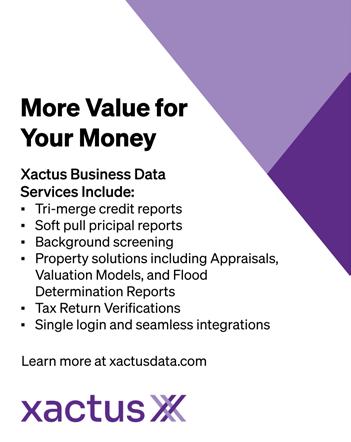
SPRING 2024 33 973.241.3300 sociumllc.com suntera.com LET’S TALK
Expertise in Private Lending Funds • Fund launch consulting • Fund accounting & admin
Loan administration services
Portfolio reporting
Investor servicing
Tax & compliance
Unparalleled
•
•
•
•
January 2023–January 2024 9.00% 8.80% 8.60% 8.40% 8.20% 8.00% 7.80% 7.60% 7.40% 7.20% $350,000 $300,000 $250,000 $200,000 $150,000 $100,000 $50,000 $0 $300,052 8.00% 7.87% 8.01% 7.93% 7.79% 7.89% 8.01% 8.14% 8.32% 8.60% Jan-23 Feb-23 Mar-23 Apr-23 May-23 Jun-23 Jul-23 Aug-23 Seo-23 Oct-23 Nov-23 Dec-23 Jan-24 $246,278 $286,659 $265,769 $258,179 $246,558 $255,239 $267,141 $270,843 $246,380 $237,636 $268,507 $249,765 8.76% 8.67% 8.26%
TABLE 7. RENTAL LOAN RATES AND AVERAGE LOAN AMOUNTS
Interest rates were also slightly more homogenous than those for bridge loans, with 50% of loans at the 8. % to 8.99% rate, leaving 39% of them above 9.0 % and just 11% under 8% (see Table 8).
The top 10 rental states by volume saw more movement last year as well (see Table 9). The top two states for 2022, Texas and Florida, each dropped a spot in 2023 as Pennsylvania moved from fourth to first and Ohio from 10th to fifth. California, a state where
it is difficult to do rental loans, now no longer registers in the top 10.
When discussing the migration changes with the largest DSCR originators, it’s a simple math problem. DSCR loans are rated based on the ratio of income produced at the property divided by the loan payment inclusive of property insurance and property taxes. When interest rates were low, many markets penciled well, but as interest rates effectively doubled from 2022 to 2023,
the dynamic shifted dramatically toward more affordable real estate markets such as Ohio and Pennsylvania.
The highest-ranked counties (see Table 10) look very different for rental loans than bridge loans, except Cook County, Illinois, which sits on both lists due to the diversity of the housing stock between the city of Chicago and its immediate suburbs.
For rental loans, the top three counties held their places between 2022 and 2023: Cook County, Philadelphia, and Essex County, New Jersey. Meanwhile, Harris and Dallas counties sank while the counties of New Haven, Connecticut, and Miami fell below the top-10 threshold.
For more information about Lightning Docs, visit https://lightningdocs.com/.

Nema Daghbandan, Esq., a partner with Geraci LLP manages the firm’s Real Estate Finance Group. Daghbandan’s practice entails all facets of lending matters across the country, including but not limited to the preparation of loan documents and addenda in all 50 states, loss mitigation efforts, preparation and negotiation of secondary market documents, including loan sales and participation agreements, line of credit/ warehouse facilities, hypothecations, and securitizations. Daghbandan advises financial institutions on various lending matters, including licensing, usury and foreclosure. Daghbandan is also an expert in default management and leads the firm’s nonjudicial trustee group.
34 PRIVATE LENDER BY AAPL
NEMA DAGHBANDAN, ESQ.
MARKET TRENDS 39% 11% 50%
9. TOP RENTAL STATES BY LOAN VOLUME 2022 2023 Texas Pennsylvania Florida Texas New Jersey Florida Pennsylvania New Jersey Illinois Ohio New York Illinois Connecticut New York California North Carolina North Carolina Maryland Ohio Indiana 3% 1% 1% 1% 5% 1% 1% 1% 5% 1% TABLE 10. TOP RENTAL COUNTIES BY LOAN VOLUME 2022 2023 Cook, IL Cook, IL Philadelphia, PA Philadelphia, PA Essex, NJ Essex, NJ Harris, TX Baltimore, MD Dallas, TX Franklin, OH New Haven, CT Harris, TX Duval, FL Cuyahoga, OH Baltimore, MD Duval, FL Miami-Dade, FL Dallas, TX Tarrant, TX Wayne, MI 4% 25% 2% 8% 1% 4% 2% Average Interest Rate: 8.3% 89% of loans were between 8.0-9.99% <8% Rate 8% >9%
TABLE 8. JANUARY 2024 RENTAL LOAN INTEREST RATES
January 2024 TABLE

You won’t find REI news there.
Stay up to date on the issues your borrowers care about with a free Think Realty membership. We are the premier media platform for real estate investors, offering news, education, tools, and resources across every sector of the industry.
Learn more and start for free today at thinkrealty.com/join.
2024 Real Estate Investor Activity: Bull or Bust?
Institutional investors may be pulling back, but smaller, local investors see opportunity.
DAREN BLOMQUIST, AUCTION.COM

There’s been some recent buzz about institutional investors pulling back on property acquisitions, but the small-volume local investors who account for the majority of investment property purchases are bullish about ramping up acquisitions in 2024 after being constrained by a lack of inventory in 2023.
“We just need more inventory,” wrote one Tennessee-based real estate investor in response to an Auction.com
buyer survey in January 2024. “How I long for the days when we’d win two or three auctions a month!”
That sentiment was echoed by a majority of survey respondents, with 60% saying they expect their investment property acquisitions to increase in 2024 compared to 2023. Another 34% said they expect their investment property acquisitions to stay the same in 2024. Only 6% said they expect their acquisitions to decrease in 2024.
1. OUTLOOK FOR 2024 INVESTMENT PROPERTY ACQUISITIONS
CARING FOR COMMUNITIES
Buyers with a primary investing strategy of renovate-and-rent were more likely to say they plan to increase property acquisitions next year (see Table 1), with 67% of survey respondents with renovate-and-rent as their primary investing strategy saying they expect acquisitions to increase in 2024.
Fifty-six percent of buyers who said their primary investing strategy was renovating and reselling to owner-occupants expect their property acquisitions to increase in 2024, while 37% expect acquisitions to remain the same as in 2023, and 7% expect acquisitions to decrease.
Regardless of investing strategy, most Auction.com buyers are typically local community developers who purchase properties locally and care about the communities where they invest.
“We’ve revitalized entire areas … and have greatly increased property values and decreased crime rates in every area we buy,” wrote the Tennessee-based investor, contrasting his small business with mammoth institutional investors who buy thousands of properties a year across the country in a variety of markets.
More than three-fourths (78%) of survey respondents described themselves as
36 PRIVATE LENDER BY AAPL
MARKET TRENDS
Expecting Decrease Expecting No Change Expecting Increase
Renovate-and-Rent Investors (Outer Ring) 31% 2% 7% 37% 56% 67% Renovate-and-Resell Investors (Inner Ring)
TABLE
Source: Auction.com January 2024 Buyer Survey
TABLE 2. INVESTOR HOME PURCHASES BY VOLUME BAND
local community developers or local investors. Another 13% described themselves as owner-occupant buyers, while only 3% described themselves as institutional investors.
INSTITUTIONAL INVESTOR RETREAT
An analysis of public record data from ATTOM Data Solutions in Table 2 shows that the biggest decrease in investor
purchases in 2023 came among the large institutional investors purchasing more than 1,000 properties a year. Purchases by those investors were down 84% from 2022 to 2023, while purchases among investors purchasing between 100 and 1,000 properties a year were down 60%.
Notably, buying entities associated with many iBuyers and single-family rental operators saw property acquisitions decrease dramatically in 2023 compared
to 2022. Purchases by Opendoor Property Trust 1 were down 67%, and purchases by SFR JV 2 Property LLC, an entity associated with Tricon Homes, were down 86%.
Purchases among all investors were down 30% between 2022 and 2023, which was just slightly higher than the overall decline in home sales of 26%. Purchases by investors buying 10 or fewer properties a year were down 18% in 2023, outperforming the overall decline in home sales by 8 points.
SPRING 2024 37
Total Investor Purchases Share of All Investor Purchases
Source:Auction.com analysis of public record data from ATTOM Data Solutions
10 or Fewer 11 to 100 101 to 1,000 More than 1,000 Total Investor Purchases 100% 90% 80% 70% 60% 50% 40% 30% 20% 10% 0% 6% 6% 11% 78% 2% 6% 10% 81% 68% 11% 9% 12% 9% 9% 11% 10% 5% 2% 1200% 1000% 800% 600% 400% 200% O% 2019 2020 2021 2022 2023 72% 83%
And purchases by those smaller-volume buyers accounted for the majority of investor purchases in 2023. Buyers purchasing 10 or fewer properties a year accounted for 83% of all 2023 home sales to investors, while buyers purchasing 100 or fewer properties a year accounted for 93% of all investor purchases, leaving just 7% for buyers purchasing more than 100 properties a year. Buyers purchasing more than 1,000 properties a year accounted for only 2% of all 2023 home sales.
LOCAL INVESTOR PROFILE
Data from the survey of Auction.com buyers align with the public record data: 70% surveyed said they purchased two or fewer properties in 2023, and an additional 26% said they purchased between three and 10 properties for the year. Only 4% said they purchased 11 or more properties in 2023.
Many of the smaller-volume investors driving the majority of investor purchases are buying close to where they live. The median distance between properties purchased and buyer mailing addresses was just 16 miles for properties purchased on the Auction.com platform in 2023. Even for sales of properties sold via online auction, which allows buyers from anywhere in the country to bid, the median distance was 21 miles.
Although most small-volume investors using Auction.com are buying locally, many prefer to leverage technology to make buying more convenient: 46% said their preferred acquisition method was an online auction or remote bid auction, both of which allow buyers to bid from anywhere with an internet connection. Another 37% said their preferred acquisition method

Q&A WITH DAREN BLOMQUIST: WHY INSTITUTIONAL/IBUYERS ACTIVITY IS DOWN
AAPL: Why is institutional activity/iBuyers down so much compared to mom-and-pop investors?
Blomquist: There are a lot of factors at play, but I think it mostly boils down to most of the institutional investors being more monolithic and more susceptible to changes in market conditions, namely mortgage rates. Just a few of those investors pulling back has a big impact on the overall volume of the group. And these investors are operating on pretty rigid business models that can be disrupted more easily by shifts in the market.
Meanwhile, smaller investors are such a diverse group with more flexible investing models that they can adjust to market conditions. Even if some of them pull back on purchasing many others are not pulling back. And even if renovating and reselling a home doesn’t make sense, many of these investors can switch to holding for rent as a backup exit strategy (or vice versa).
AAPL: So, to get more granular, can the decrease in activity be attributed to iBuyers being ahead of the wave (with the rest of the market to follow), or have some of the predicted issues with iBuyers proven true?
Blomquist: I would say it’s more of the latter (getting eaten up by the curve). It was always a question in my mind about whether that business model could experience robust growth in a slower market, both in terms of home price appreciation and number of sales.
38 PRIVATE LENDER BY AAPL
MARKET TRENDS
TABLE 3. 2024 INVESTMENT PROPERTY ACQUISITION OUTLOOK BY REGION
was in-person foreclosure auction, 10% said they prefer the multiple listing service (MLS), and 7% said they prefer to acquire off-market properties.
“I still work full time so I can only explore online auctions,” wrote a Kentuckybased Auction.com buyer, who said her primary investing strategy is to renovate and live in homes for three to five years. “I enjoy old homes with character that flippers don’t want to mess with.”
Although building wealth for themselves and future generations
was the top motivation for all buyers surveyed, improving neighborhoods ranked second highest in terms of motivation for investing in real estate.
“My completed renovations provide homes to locals at prices below what they can find on the Realtor MLS and I still make money!” wrote a Mainebased real estate investor, who said his primary investing strategy is renovating and reselling to owneroccupants. This investor said he spends between $50,000 and $100,000
on average renovating the properties he purchases on Auction.com.
WHERE LOCAL INVESTORS ARE MOST BULLISH
Auction.com buyers in the Southeast and West regions of the country were most bullish on increasing property acquisitions in 2024 (see Table 3), with more than two-thirds of buyers in both those regions saying they expect acquisitions to increase. Buyers in the Northeast were least bullish, but more than half of
SPRING 2024 39
Central Northeast Southeast West All Buyers 56% 55% 65% 69% 60% 34% 25% 30% 39% 39% 5% 5% 5% 6% 6%
Source:Auction.com January 2024 Buyer Survey
Expecting Increase Expecting No Change Expecting Decrease
them (55%) still expect acquisitions to increase in 2024, and 56% of buyers in the Central region of the country expect their property acquisitions to increase.
Buyers are generally bullish about increasing acquisitions in 2024 despite a majority in most regions describing their local markets as overvalued with a correction possible. Nationwide, 49% of buyers described their local market as overvalued, but in the Northeast, 58% described their local market that way—the most of any region, followed by the Southeast and West, both at 52%. The Central region was the only one where a minority of buyers (41%) described their local market as overvalued with a correction possible.
OWNER-OCCUPANT BUYERS ALSO BULLISH
Somewhat surprisingly, 59% of Auction. com buyers describing themselves as owner-occupants said they expect to increase property acquisitions in 2024. That could be because many buyers who purchase a home for themselves end up purchasing more properties as investments.
“I bought my current home [on Auction. com] 10 years ago and wish there were as many listings for [my ZIP code] as there were in 2013 to 2014,” wrote a California-based survey respondent who described himself as an owneroccupant buyer. “We have a dearth of affordable homes. I’m always looking for ways to improve this situation.”
DAREN BLOMQUIST

40 PRIVATE LENDER BY AAPL
Daren Blomquist is a vice president at Auction.com, where he analyzes and forecasts complex real estate data and trends for the nation’s leading online real estate marketplace to bring unparalleled transparency and certainty to real estate transactions. Daren is a frequent source for national news outlets such as Associated Press, New York Times, and CBS News, and he has been cited in hundreds of local newspaper and radio interviews.
KNOWN NATIONALLY LOVED LOCALLY. Growing our footprint in local markets and looking for top tier talent to bring the Renovo Experience to more local investors. For more information contact James Gaskin: james@renovofinancial.com MARKET TRENDS









SPRING 2024 41 White Label Table Funding Full Technology Suite Concierge Service Full Back Office Support 360 Experience The leading capital provider for private lenders

Ebb and Flow of Private Lender Capital Strategies
In the changing lending landscape, private lenders have three basic options when originating loans. Which option is best for you?
MICHAEL FOGLIANO AND SEAN MORGAN, FORECASA
42 PRIVATE LENDER BY AAPL MARKET TRENDS


he terms “data” and “analytics” have become ubiquitous for good reason. Within every industry, there has been a huge shift from reliance on personal networks to gather anecdotal information to a more techsavvy approach to capture data points.
Collecting data just because it’s the recommended thing to do won’t help you run your company, however. It takes time and effort to curate the data into a usable format to generate real analytics that you can rely on to make strategic decisions about how to run your business.
This is especially true in the private lending business. For the past four years, our team has been gathering, cleaning, and analyzing residential real estate data sourced from county land record transactions, with a special focus on activities within the private lending space. With investors, originators, and capital partners recording documents under different entities, it’s hard for you to measure true activity when looking at the data in its raw format.
Our team uses a proprietary method we developed to normalize the party names and localized transaction type
nomenclature for a clearer view of the true activity occurring daily. From these inputs, you can examine the various capital markets strategies used within this otherwise opaque industry.
SETTING THE STAGE
We define private lender as a mortgage originator offering short-term fix-to-flip/bridge loans, 30-year DSCR loans (30-year rental loans), ground-up construction, and/or multifamily loans to residential investors. Based on this
SPRING 2024 43
definition, the underlying transactions are reviewed to ensure the lenders we tag as ”private lenders” are truly private lenders. After identifying the private lenders and tagging them, we can aggregate and analyze the data to create visibility into the private lending market. Although other lenders may offer these products, we exclude them from this tag and
categorize them into their own buckets (e.g., conventional, non-QM, etc.).
MARKET SNAPSHOT
The size and composition of the private lending market has changed during the last two years. In absolute terms, mortgage activity has been down across
the board, as noted in tables 1 and 2. However, private lending has grown its share of the pie. In 2023, private lending made up 4% of all mortgage loans, compared to 3% in 2022. This is because non-private lending (-34%) took a much bigger hit than private lending (-20%) year over year.
44 PRIVATE LENDER BY AAPL
MARKET TRENDS
TOTAL MORTGAGE TRANSACTIONS LINE ITEM PRIVATE LENDING NON-PRIVATE LENDING TOTAL PRIVATE LENDING MARKET SHARE 2022 160,426 4,715,321 4,875,747 3% 2023 127,677 3,114,037 3,241,714 4% % Change -20% -34% -34%
TABLE 2. PRIVATE LENDING MARKET SHARE
2022-01 2022-02 2022-03 2022-04 2022-05 2022-06 2022-07 2022-08 2022-09 2022-10 2022-11 2022-12 2023-01 2023-02 2023-03 2023-04 2023-05 2023-06 2023-07 2023-08 2023-09 2023-10 2023-11 2023-12 20,000 18,000 16,000 14,000 12,000 10,000 8,000 6,000 4,000 2,000 0 600,000 500,000 400,000 300,000 200,000 100,000 0
TABLE 1. MORTGAGE TRANSACTIONS BY QUARTER, JANUARY 2022-DECEMBER 2023
Non-Private Lrending Total Transactions Private Lending Total Transactions
Source: Forecasa™
The composition of the market has also changed, as noted in Table 3. In 2023, we identified 5,407 active private lenders. Twenty-three percent of these lenders were new entrants to the market. In other words, nearly one-fourth of private lenders with originations in 2023 originated no loans the previous year.
At the same time, nearly 30% of private lenders in 2022 exited the market.
The private lending industry is a highly disaggregated market—the top 10 lenders account for only 23% of private lending loan originations in 2023. This typically averages around 25% for private lending since 2019. Additionally, 51% of
the loans came from lenders with fewer than 100 loans originating in 2023.
CAPITAL STRATEGIES: PRIVATE LENDER LOAN EXITS
In the changing landscape, private lenders have a few options when originating loans:
1. Securitize
2. Originate to sell
3. Balance sheet loan via fund/ bank warehouse line
The biggest players can originate to securitize, but new players have been entering this otherwise limited group.

























SPRING 2024 45
TOTAL PRIVATE LENDERS NEW ENTRANTS EXITS 2022 5,843 (Not tracked from 2021) 1,696 (29%) 2023 5,407 1,260 (23%)
TABLE 3. PRIVATE LENDER MARKET ENTRANTS AND EXITS
The most widely used strategy, noted in Table 4, is originating to sell on the secondary market. However, in third quarter 2022, many originators experienced offtake issues with the
secondary market due to the quickly rising interest rate environment. There are only soft commitments that exist between the originators and the secondary market, which can cause sudden and impactful
decisions for capital markets teams throughout the space.
This lack of assurance has led to more lenders establishing a fund via Form D filing with the SEC to raise their own capital.
*Note: %s will add to > 100% as there is overlap between categories



in







46 PRIVATE LENDER BY AAPL MARKET TRENDS
Let’s Stay
707-838-1679 cisinspects.com inspects@cisinspects.com Construction Progress Inspections Construction Cost Analysis Plan and Cost Reviews Cost to Complete Consruction Reviews Annual Commercial Portfolio Reviews Lender Solutions for Construction Risk Management Services PLATINUM CLUB WE REWARD YOU FOR YOUR SUCCESS! (800) 473-6051 CS@COGOCAPITAL.COM 701 E FRONT STREET 2ND FLOOR COEUR D’ALENE, ID. 83814 Loans are available only on non-owner occupied real property NMLS #1760709; Arizona Mortgage Broker License #0950084 California Finance Lenders License 60DBO-101344 Cogo Capital Underwriting Guidelines are subject to change without notice This is not a commitment to lend All offers of credit are subject to approval Restrictions may apply 100% Purchase, Rehab and Closing 9.75% Interest Rate Up to 75% ARV No Application Fee Full Appraisal (up to 75% ARV) And MORE
STRATEGY % OF TOP 50 PRIVATE LENDERS NOTES Securitize 12% Limited to the largest players Originate to sell 80% Lender diversifying partners Balance Sheet loan via fund 36% Fastest growing segment
TABLE 4. EXIT STRATEGY POPULARITY

STRATEGY TRADEOFFS: VOLUME VS. STABILITY
Generally speaking, lenders who had funds experienced a more stable 2022 and start to 2023 in terms of loans originated. The regional players with their own funds were able to maintain activity levels more consistently than those with high leverage on the secondary market (see table 5).
Of the top 100 private lender funds, the following shows how long they have been around as well as the median size of the funds:
Less than 12 months: 21% 12-24 months: 12% 24+ months: 67%
Median Number of Investors: 39
Median Total Offering Amount: $50 million
Table 5 provides examples of two real private lenders:
Lender A: Lender that sells 90% + of their loans.
Lender B: Regional lender from the Midwest that keeps all loans on the balance sheet through funding they raised via their Form D filing.
SPRING 2024 47
600 500 400 300 200 100 0 100 90 80 70 60 50 40 30 20 10 0 Q1 2021 Q2 2021 Q3 2021 Q4 2021 Q1 2022 Q2 2022 Q3 2022 Q4 2022 Q1 2023 Q2 2023 Q3 2023 Q4 2023
Forecasa™ Lender A: Number of Transactions Each Quarter Lender B: Number of Transactions Each Quarter
TABLE 5. COMPARING BALANCE SHEET VS. LOAN SALE FOR TWO LENDERS
Source:


Michael Fogliano is a product manager at Forecasa, responsible for product development and data analysis. After studying mathematics, Fogliano gained experience in several different industries but always worked with complex data.
As Table 6 notes, there has also been a shift away from exclusive relationships pertaining to loan buyer/loan seller activity. In 2022 and prior, it was common for an originator to have one or potentially two active note buyers. Toward the end of 2022 and throughout 2023, originators did a better job of diversifying their capital markets risk by increasing their number of active capital relationships. Whether it will be with loan aggregators, local banks, insurance companies, etc., we
expect this trend to continue because most of these relationships are not contractual/guarantees to buy.
In summary, private lending is down from its peak in March 2022 but is growing relative to conventional lending. Capital markets teams for the originators have had their work cut out for them during the past 18-24 months but have done a good job securing new options to fund their originations. We expect this trend to continue as more of the larger originators focus on TPO strategies.

Sean Morgan is the founder and CEO of Forecasa, where his primary focus is product and business development. With a background in oil and gas intelligence, Morgan helped his team achieve a successful exit several years ago before entering the lending analytics space. Morgan began his career as a CPA for PwC, cultivating a strong foundation in data interpretation and strategic insights.
48 PRIVATE LENDER BY AAPL
SEAN MORGAN
MARKET TRENDS
MICHAEL FOGLIANO
YEAR TOTAL RELATIONSHIPS # OF LOAN BUYERS # OF PRIVATE LENDERS (LOAN SELLER) 2022 1,873 611 781 2023 1,981 582 767 AVERAGE # OF PRIVATE LENDERS A SINGLE LOAN BUYER WORKS WITH AVERAGE # OF LOAN BUYERS A SINGLE PRIVATE LENDER WORKS WITH 2022 3.06 2.4 2023 3.4 2.58
TABLE 6. ANALYZING LOYALTY TO LOAN BUYERS

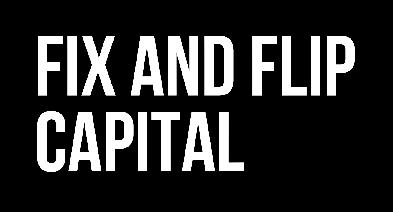




All loans must be solely for a business or commercial purpose and secured by a non-owner occupied property. Products not available in AZ, ND or VT. In CA, ID, MN, NV, OR and SD, products o ered by Fay Servicing, LLC d/b/a Constructive Mortgage Services, NMLS ID # 88244 CA: Licensed by the Department of Financial Protection and Innovation. All loans made and arranged in California pursuant to a California Financing Law License # 60DBO-82792. Please visit www.nmlsconsumeraccess.org for additional licensing/registration information. In all other states not previously listed, products are o ered by Constructive Loans, LLC d/b/a Constructive Capital. This advertisement is intended for mortgage professionals only. Rates, terms, and conditions are subject to change from time to time without notice.

50 PRIVATE LENDER BY AAPL LENDER LIMELIGHT WITH MELISSA MARTORELLA

Right Place, Right Time
A cross-country move for a career change is one of the biggest leaps Melissa Martorella has made. The risk paid off.
BY KATIE BEAN
Across-country move for a career change is one of the biggest leaps Melissa Martorella has made. The risk paid off.
Growing up in the small town of Winchendon, Massachusetts, Melissa Martorella attended Boston College for undergraduate and Tufts University in the Greater Boston area for graduate school. She spent a few years teaching Spanish before returning to a dream she’d had for a long time: becoming a lawyer.
“I really like the idea of being able to stand up for the answer that you think is the correct one, or being right in an argument, or finding your way to whatever could be right,” she said. “That’s always been something interesting to me.”
She applied to several law schools, including Boston College, but ultimately decided on the University of California,
Irvine School of Law. Martorella had enjoyed previous visits to California, and she felt “stuck” in Massachusetts. Her brother and sister had moved away, so she felt pulled to explore.
“I figured if I hated it, I could always go back home. But I thought like I should have this experience of trying to live somewhere else and try a new place,” she said.
The move didn’t go smoothly. Martorella shipped her belongings, and the delivery was delayed. She ended up borrowing her new roommate’s camping mattress and sleeping bag. She didn’t know anyone at her new school, nor did she have any professional connections in the area. But she took it one day at a time, and the move paid off.
During law school, Martorella discovered she didn’t like litigation and preferred
SPRING 2024 51
the more transactional side of law, such as contracts. When she began looking for jobs in her final year, she found Geraci LLP in Irvine, California, was looking for a new attorney. The role was “a perfect match,” she said. She’s been at the firm for more than eight years and is now a partner and director of the banking and finance department.
A Path with Learning Curves
Martorella acquired many of her skills through on-the-job training. She didn’t know anything about the private lending industry when she started at Geraci, she said, though she knew a little about real estate and property through her father’s work as a land surveyor.
She also believes luck and good timing have helped to propel her career, joining the firm when it was still relatively small and learning about all its aspects.
“Now, my team is bigger than the whole firm was back then. And I think it’s also easier to grow and be a part of something and part of leadership when you’re in earlier,” she said. “I do think I am a smart, capable, hard-working, intelligent person. But I do think there’s a lot to be said of right place, right time—that kind of all aligning.”
Martorella is part of the Lightning Docs team, led by her colleague Nema Daghbandan. Lightning Docs is an automated loan document

solution built from scratch at Geraci. Martorella has also had a hand in managing firm operations.
Building Lightning Docs was its own education, she said. Her early work at the firm included creating loan documents for clients in different states. It was an involved process that meant looking for template documents with accurate local verbiage, conforming the state’s specifics to Geraci’s standard templates, and
finding counsel in each state to review the documents for compliance.
“I think I had a deeper understanding of what was going on faster because I couldn’t rely on just clicking a button to do the things that help us scale now,” she said.
Having done that legwork, she and her colleagues have built a platform that allows them to create accurate and compliant loan documents in a fraction of the time. It was painstaking work to create the master documents.
52 PRIVATE LENDER BY AAPL
LENDER LIMELIGHT WITH MELISSA MARTORELLA

“I think we had templates for all 50 states for loan documents. But then it was like, well, section 47 of this mortgage is different from section 47 of this deed of trust—it was just all over the place,” she said. “You really have to learn the documents and learn what they’re saying to be able to do something like that. … I learned so much through that process, versus now, my attorneys have no idea what went into that and all they know is ‘Oh, I have a loan in West Virginia and
the docs are good,’ and they don’t know what we went through to make sure that it did work the way that it does now.”
In that respect, Martorella refers back to the luck of her timing. If she came to the firm now, the work has been done and the learning opportunity wouldn’t be available for her. Now, however, she understands how the firm can scale and flourish thanks to the work she and others put into the Lightning Docs venture.
“I can have people with less experience doing more difficult transactions now because a lot of it’s automated,” she said.
Charting a Leadership Journey
Putting in the hours and effort she did to help create Lightning Docs has paid
SPRING 2024 53
Melissa Martorella with her senior loan processors (right to left): Christine Abdale, Audie Munoz, Melissa Martorella, Tracy Le, Michael Traylor
I’m teaching people to take a stab at it, try to figure it out, and I’ll help you get it to where it needs to be.
off not only for the firm but also for what Martorella called one of her biggest challenges: finding work/life balance.
“I would say a big way of overcoming that and figuring that out is realizing you have to build the team and train people and work with people and loosen up a little bit,” she said.
As her team has grown, she’s learned that delegation affords her the flexibility she didn’t have early on in her career. She admits that letting go of some control has been difficult, but having the right people on her team made it possible.
It has freed up time for her home life: spending time with her partner, Mark Metrakos, and their three dogs, from left to right, Romeo, Kim, and Wayne; traveling to visit family; and reading, exercising, and watching Oscarnominated films. She also has more time for work-related efforts, including serving on the Education Committee for the American Association of Private Lenders and mentoring her employees.
Mentoring has been critical to advancing Martorella’s knowledge and career. One of the partners at Geraci, Nema Daghbandan, took her under his wing from Day One at the firm, she said.

54 PRIVATE LENDER BY AAPL
LENDER LIMELIGHT WITH MELISSA MARTORELLA
Melissa Martorella pictured with partner, Mark Metrakos, and their three dogs, from left to right, Romeo, Kim (held by Mark), and Wayne.

“I used to sit in his office all day, every day, looking over his shoulder, being on calls, learning how to write different provisions,” she said. “I really learned a lot from him, and I think, as a mentor, he did a great job of always making me feel supported, but also giving me the freedom to try to figure things out on my own.”
She uses her experience as a mentee to inform how she helps others on her team.
“I’m teaching people to take a stab at it, try to figure it out, and I’ll help you get it to where it needs to be. But I want you to go for it yourself,” she said. “I think that kind of mentality helped me to succeed.”
From being on both sides of mentorship, Martorella offers these tips for success:
“There’s something to be said for making sure you are mentoring the right person. … If you are the person
Favorites
MOVIE:
All of the Avengers movies through the Infinity War saga. “I’m a huge Marvel fan.”
PLACE TO TRAVEL:
“Last May, Mark and I went to Paris, and it was phenomenal. That was probably one of my favorite trips. I also studied abroad in Madrid, and that was an amazing experience.”
BOOK FOR PLEASURE:
“The Pendergast series by Douglas Preston and Lincoln Child, which fits into her favorite genre of sci-fi mystery thrillers.”
SEASON:
Fall. “One of the main reasons I do miss the East Coast. It’s a lot more picturesque in the Northeast.”
WEEKEND ACTIVITY:
Something outdoorsy and physically active, especially if she can include her dogs.
WAY TO RELAX:
Cuddling on the couch with her dogs
GUILTY PLEASURE:
Watching “The Kardashians” and eating chocolate-covered pretzels
SPRING 2024 55
This or That
CALL OR TEXT: Text
COFFEE OR TEA: Hot coffee only
COMEDY OR MYSTERY: Both
REALITY TV OR SCRIPTED
DRAMA: Scripted drama
CROSSWORD OR SUDOKU: Sudoku. “I love number puzzles and number games.
FUN FACT: My high school graduating class superlative was ‘Most likely to succeed in mathematics and physics,’ and I clearly went a different route with that.”
JOGGING OR WEIGHTLIFTING: “I don’t like jogging. I like running, but then I also have recently learned to love weightlifting as well.”
DOG OR CAT: “Dogs all day!”
RAIN OR SHINE: Shine. “I like a good rainy day, but I much prefer the nice, sunny weather.”
NIGHT OWL OR EARLY BIRD: “I am trying to become an early bird. … I can’t stay up late anymore.”
PLAN AHEAD OR WING IT: Plan ahead. “The anxiety of winging it would just destroy me.”
DINING INDOORS OR AL FRESCO: Al fresco. “But if it’s too hot, I would rather die. I do like eating outside, but I can’t be in the sun.”

mentoring others, make sure you’re picking people who have the skills and the drive and the ambition.”
“If you are looking to be mentored, be the person that’s going to make it as easy as possible.” She said she would seek out what she thought the answer to a problem would be and then bring it to Daghbandan, rather than waiting for him to tell her the next step to take.
LENDER LIMELIGHT WITH MELISSA MARTORELLA
56 PRIVATE LENDER BY AAPL

“If you want to learn something that I know how to teach, get it on my calendar, but I’m not going to put it on your calendar. … If you make it a priority, I will be there for you.” Being a mentee is not like being a student where a teacher initiates the lessons. She emphasized that it’s the mentee ‘s responsibility to be proactive.
In addition to mentorship, Martorella checks in monthly with each member of her team, which includes remote and
in-office employees. Her senior team members have more frequent check-ins with everyone, and they stay in constant communication with her, she said.
“I think that gets a bad rap sometimes, especially on social media, that you have overbearing managers, but I don’t think it’s that. I think it’s really that we do care, and people appreciate that. It’s a really good working relationship, especially on our team.”

SPRING 2024 57
Katie Bean is a former newspaper and magazine editor who loves telling the stories of businesses and great leaders. She is based in Kansas City.
KATIE BEAN
2024 Market Update: Vintage Is In
This year will favor investors who focus on what they do best, base their growth plans on solid due diligence, and embrace old-school underwriting principles.
SCOTT WARD, AAPL FUND FORUM HOST

Things won’t be boring in 2024 as some markets start to heat up, others cool, and rumors of possible interest rate cuts swirl around in daydreams of better days ahead. CNBC noted that in 2024, the Fed could lower interest rates as many as three times, giving new optimism to both investors and buyers. That said, there is no crystal ball, and this is an election year.
Factors to consider (beyond the rates and prices that seem to be stabilizing) are

58 PRIVATE LENDER BY AAPL FUND MANAGEMENT
always the Big Two: exit and payment. These two issues are affected, especially in 2024, by the murky projections for unemployment, the constant flow of migration to new markets, and the international flow of money into the investment real estate sector. One tide rises while another falls.
EMPLOYMENT AND WAGES
According to the Bureau of Labor Statistics January jobs report, employers added
350,000 jobs in January alone, posting the highest or strongest (depending on who you ask) gains in more than a year. December numbers were “revised” to show strong numbers as well, corrected from 216,000 to 333,000. One could argue, therefore, that the employment sector is picking up steam, thus embracing investors’ ability to find strong exits with strong end buyers.
Jobs create growth in varied MSAs and support the drive for (in at least certain

areas) new construction and mid-market rehab properties. Federal Reserve Chairman Jerome Powell has stated in numerous interviews that his goal is to reach a 2% goal of inflation. Again, no crystal ball, and no one is a financial Nostradamus, but with strong jobs sectors come stable real estate markets. Certain metros will benefit greatly from this. There will be solid values, short sales cycles, less listing time on the market, and higher rental/DCSR values.
Growing employment numbers also bring growing, or at least stabilized, wage numbers. The same jobs and economy report states that wages are on a slight uptick from a small decline in early 2023 and massively up from the pandemic. This can be misleading, however, as some areas (e.g., the Texas Triangle, Kansas, Oklahoma, northeast Arkansas, and the Florida Panhandle) of the Southeast are firing off like a Roman candle in real estate values and income levels, whereas other cities are stalled and may not come back, thus needing investors who are hyperlocal and prepared to play the long game.
Many investors are waiting for a bottom in some of these Midwest and Pacific Northwest markets, as jobs continue to move South and into Central Plains states. According to the Bureau of Labor Statistics, as of December 2023, Western states, specifically California, Washington, Oregon, and parts of Arizona, show a massive jump above average in unemployment and high numbers of migration as families and younger Americans move to more stable and affordable markets.
The numbers for international investors/ buyers are also up for markets in California, Seattle, and Oregon, whereas the number of unemployed is much
SPRING 2024 59
lower in Texas, the Central states, the Carolinas, and Florida. Along with the unemployment rates being lower in these markets (proven for the past 18-24 months), there is a massive opportunity for housing development and rehab of older and existing properties. Job creation corridors bring new people, more jobs, and massive long- and term short-term investment options. As everyone knows, bringing new life into declining markets is a gamble and long-term game at best, and most certainly a volume play.
GROWTH CONSIDERATIONS
You’ve probably heard the following two sayings many times: “Stick to your swim lane” and “Do what you do best—and leave the rest.”
This year is going to require a keen eye for each investor group, debt fund, trust deed crew, and direct lending hybrid. Private investors are looking to invest in funds with a clear two- to three-year growth plan; that is, these debt fund investors are looking for stability and strong exits. When asked what products they are looking for as a fund investor, the resounding answer is “stable properties” (i.e., ones they won’t get stuck with because the investment just sits with no distribution).
The sting of 2008 still lingers to this day. Fund managers who want to attract investors with capital need to (1) make sure underwriting meets their PPM and mission statement, (2) select markets where they have a solid footing, and (3) never attempt to launch a whole series of new lending products that are new to both the manager and the investor.
Now is not the time for a debt fund to be an inch deep and a mile wide. This market may be like a store where there is a “hat
for every head,” but “not every head fits every hat.” Stick to the asset classes and markets that fit your proformas best, where you have experience (and success), and where things are manageable should the capital markets go haywire again.
During the past few market cycles, many companies have been more concerned about growing footholds in new markets and have gotten caught learning on the downside of a trend rather than the upside.
This is not to say to look away from growth in 2024; growth is necessary to survive. Growth, however, needs to be managed with deep due diligence and extensive market research; in other words, a “look before you leap” mindset. Growing just to grow is never a solid idea without having the information necessary to inform your opportunities and risks. Without it, you may as well be running through a minefield. Sure, you may make it; but it’s not a game that will last long, and it could end quickly in a bad way.
Another topic often discussed by market speculators is the new “thing” in assets and niche funding products. Every market has its new “darling”—build-to-rent, multifamily, office space conversion, accessory dwelling units (ADUs), halfway houses, ground construction, managed health care—you name it!
Lately, there has been a significant push for ADUs (especially in college and student housing markets, job creation corridors, and coastal areas with short raw land availability) and halfway houses in certain markets and buildto-rent and office conversion in others. As mentioned earlier, it appears 2024 will bring more stability; however, it’s also an election year. Everyone would do best to circle the wagons and stick to
their core competencies without trying to grab every new lending or real estate concept that comes down the pike.
2024 will favor companies that are an inch wide and a mile deep. One thing is as sure today as it was 100 years ago: Investors won’t invest in what they don’t understand, and they certainly won’t invest in a random niche investing idea that has a six-week shelf life.
If we focus on what we do best, grow using information gleaned from solid due diligence, and embrace old-school underwriting principles, 2024 will be better for us all.
SCOTT WARD

Throughout his extensive 25-year career, Ward has successfully underwritten and closed thousands of private money residential, commercial, and raw land investment loans. He has been involved with several equity funds that specifically focused on investment property throughout many verticals (all nonowner occupied) covering 11 states. He is a panel speaker for real estate equity investments and commercial development properties as well as an AAPL Certified Fund Manager and a current member of the AAPL Education Committee.
60 PRIVATE LENDER BY AAPL
FUND MANAGEMENT
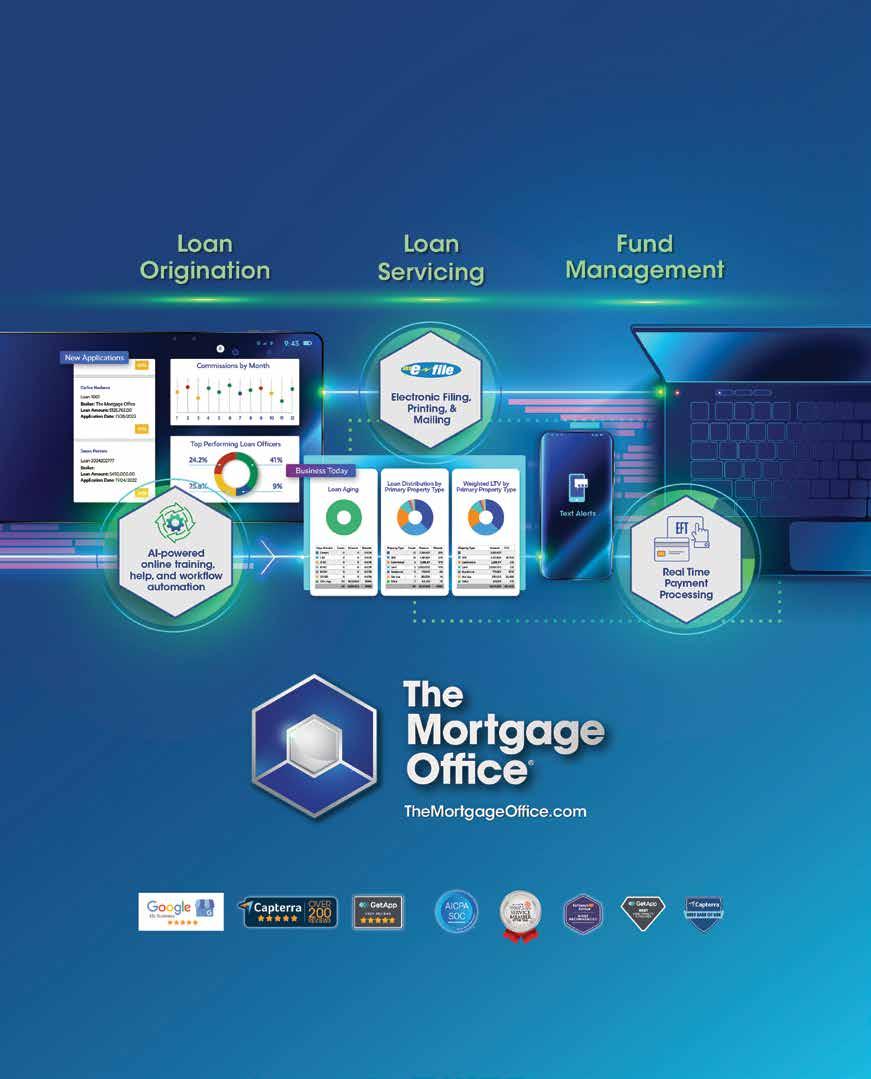
(800) 833-3343 TheMortgageOffice.com 2847 Gundry Avenue, Signal Hill, CA 90755 sales@absnetwork.com The Best Loan Management Software in Private Lending Trusted by Thousands of Companies Across the Globe
Distressed Property Undergoes Impressive Rehab for Section 8
Rehabber converts distressed single-family home into a fourplex that improves an upscale neighborhood—and provides affordable housing.
ADONIS LOCKETT, LNH CAPITAL

THE OPPORTUNITY
LNH Capital saw an opportunity to rehab a highly distressed 1-bedroom, 1-bathroom property to match the look and feel of the multimillion-dollar neighborhood in which it is located—and realize hundreds of thousands of dollars of equity via value appreciation.
EXIT STRATEGY
The exit strategy was to refinance into a long-term investor rental loan.




62 PRIVATE LENDER BY AAPL
CASE STUDY

LOAN DETAILS
Lender // LNH Capital
Property Location // Virginia Ave., Dallas, Texas
Year Built // 1959
Architecture Style // Colonial Square Footage // 4,906
Original Loan Amount // $425,000
Length of Loan // 30 years
Anticipated Rehab Costs // $350,000
LTV // 80%
LTC // 85%
Interest Rate // 7.95%
Credit Score Considered? // Yes
Borrower Experience Level // Extensive/Highest Level
SOLUTIONS & OUTCOMES/ RESULTS OF LOAN
As a result of the rehab, the property value increased more than a million dollars.
Total rental income went from $4,000 a month as a single-family residence to $10,000 a month across four units. This earns additional income for the housing provider, and based on local rents, means more affordable housing for local families.
An important aspect of the approach involved partnering with Section 8

housing assistance programs. Under this arrangement, Section 8 provided a premium to relocate families from lower-income areas to higher-income neighborhoods. Not only did this provide better living environments for these families, but it also allowed for the optimization of revenue streams. Previously, landlords were burdened with property maintenance costs resulting from tenant neglect. However, with the evolution of Section 8 policies, tenants are now responsible for property upkeep. This shift has been instrumental in enabling a 24% increase in revenue by renting to Section 8 tenants.
By focusing on Section 8 tenants, LNH Capital realized its tenant demographic was predominantly single mothers with multiple children. With the highest density of voucher holders being three-bedroom vouchers, LNH ensured units were tailored to appeal to this demographic.
By transitioning the property into multiple units, LNH created the opportunity to house more families and give them access to newly renovated dwellings in desirable neighborhoods. This not only elevates their living standards but also presents opportunities for better schooling and enhanced community
amenities, fostering a mutually beneficial environment for all stakeholders involved.
This project showed the borrower’s dedication to providing quality housing solutions while uplifting communities and improving lives.
ADONIS LOCKETT

Adonis Lockett is the owner of a private equity fund and principal of LNH Capital. He's the chairman of Lockett-N-Homes, a national real estate investment firm and real estate brokerage, founder of myRE360, and creator of Smart Money Blueprint, an education series that teaches people how to start, grow, and scale a real estate investing business.
Lockett holds a bachelor's degree in electrical mechanical engineering and is Lean Six Sigma Certified.
Lockett is also a national speaker and has appeared on several television programs providing insight on real estate investing.
SPRING 2024 63
Operational Procedures for a Foreclosure
Time is of the essence with foreclosures. Being familiar with the procedures involved will save you time and make the process smoother.
HENRY CHAVEZ, SPIEGEL ACCOUNTANCY

our borrower has not paid their $1,000,000 mortgage note receivable for three months. You, therefore, decide to foreclose on the loan. But you haven’t performed a foreclosure in the past, so you need to determine the appropriate operational procedures.
Foreclosures are a laborious process and can take anywhere from 120 to 180 days to complete. Beginning the process as soon as possible is critical. Many private equity fund managers start the process immediately after a borrower has been delinquent for 30 or more days. The first step is to discuss the issue with legal counsel, who will determine the appropriate foreclosure laws for the state in which the foreclosure will occur. Once legal counsel has informed you of the applicable laws, you will be ready to take action.
Although foreclosure laws vary from state to state, there are some commonalities to the process. We’ll use a case study to illustrate them.
DETERMINING FAIR VALUE
The foreclosure process will involve a public auction. Before the public auction
day, you have to set a minimum bid price; most people set it at par value. Once the property goes to auction, you will have one of two outcomes: the property will either be sold or it will revert to you at the bid price.
From an accounting standpoint, you need to convert the mortgage note receivable to a real estate-owned property (REO). Fortunately, whether your accounting policies require that you use the accrual (cost or fair value) or income tax accounting treatment, the outcome will be the same. Specifically, the property will need to be marked to fair market value, which is obtained through either a valuation report from a credentialed valuation expert or a broker’s price opinion report. Before you decide to invest in either, check with your CPA because they may
have specific requirements regarding the type of report that you need.
An auditor will also inquire about the overall valuation reasonableness test(s) performed to ensure the property valuation is reasonable. Using residential property as an example, you could start by cross-checking the property valuation against major real estate databases such as Zillow and Trulia. Alternatively, an independent cash flow analysis can be performed to determine whether your fair value assessment is similar to the valuation received. For example, the valuation received for the property in this example was $1,400,000.
DETERMINING COMMISSION
The next step in the process is to determine the appropriate commission to sell the property. Using a rate of 5%, the commission expense would be deducted against the fair value of the property. The fair value, net of estimated cost to sell (net realizable value), would be $1,330,000 ($1,400,000 less commission of $70,000).
CREATING AN REO RECEIVABLE
The next step is to reduce the book value of the mortgage loan receivable plus any accrued interest receivable to create an REO receivable for the net realizable value of the property. The difference, in this case, is recorded as an unrealized
64 PRIVATE LENDER BY AAPL
LINE ITEM DEBIT (DR) CREDIT (CR) Mortgage Loan Receivable $1,000,000 REO $1,330,000 Unrealized Gain on Loan Conversion to REO $330,000 CASE STUDY

gain on the property, and the entries on the balance sheet and profit and loss statements would be reflected as follows:
It is important to note that several different scenarios exist with the REO at this point, and a different accounting treatment will need to be employed for each of the following scenarios:
Scenario 1. Additional costs may be required to bring the REO to completion. Under this scenario, you will be required to capitalize the additional costs of construction but will also be required to periodically compare the book value of the REO with its fair value to determine whether the asset is impaired.
Scenario 2. The REO may be sold as is. Under this scenario, you will only be required to
record the final transaction with a realized incremental gain or loss on the sale.
Scenario 3. The REO may be held for investment and rented. Under this scenario, the property will have to be depreciated.
Ultimately, for this particular property, you decided to sell it as is. You received a post-commission offer of $1,450,000.
The correct entries to complete this transaction are as follows:
REO transactions can be complex, and various other variables can change your strategy about how to dispose of and account for them. Consulting with the appropriate professionals is prudent.
HENRY CHAVEZ

Henry Chavez works with thriving organizations, serving as a strategic resource for their growth and success. During a public accounting career spanning nearly three decades, Chavez has provided assurance and business advisory services to privately held businesses in the financial services, manufacturing and distribution, technology, and nonprofit sectors.
Chavez is a member of the American Institute of CPAs and the California Society of CPAs. He serves on the Education Committee for the American Association of Private Lenders and provides training on financial accounting and reporting issues related to the private lending and mortgage banking industries.
SPRING 2024 65
LINE ITEM DEBIT (DR) CREDIT (CR) Cash $1,450,000 REO $1,330,000 Realized Gain on Sale of REO $120,000
Land Value Creates Build-and-Flip Opportunity
Borrower will build estate on a 1-acre property in a quiet and peaceful cul-de-sac and flip it.
ERIK

OPPORTUNITY
The borrower found an incredible 1-acre property in an idyllic Atherton, California, cul-de-sac surrounded by luxurious estates and located in the acclaimed Las Lomitas Elementary School District. Recognizing the value of the land, the borrower was able to build a sprawling new estate in an exclusive enclave of luxurious properties. The setting is serene yet convenient to Sand Hill Road venture capital centers,
downtown Menlo Park, and Palo Alto. The exit strategy is to build and flip.
SOLUTIONS & OUTCOMES/ RESULTS OF LOANS
This is a refinance, no cash-out bridge loan to give the borrower additional time to get plans/permits ready to build a new home on this lot. The lender is crossing this deal with a lot the borrower owns free and clear as well as a separate loan.

LOAN DETAILS
Lender // Center Street Lending
Property Location // Atherton, California
Square Footage // 2,190 (existing home)
Original Loan Amount // $4,999,000
Interest Rate // 10.5%
Anticipated Rehab Costs // $350,000
LTV // 80%
LTC // 85%
Interest Rate // 7.95%
Credit Score Considered? // Yes
Borrower Experience Level // Highly experienced

Erik Brown is a loan origination manager at Center Street Lending, where he's also gained experience in operations, underwriting, and sales.
66 PRIVATE LENDER BY AAPL
BROWN, CENTER STREET LENDING
CASE STUDY
ERIK BROWN


Release Operational Pressure by Breaking Bottlenecks
When you are diligent about eliminating the bottlenecks, your funnel widens and your company becomes more profitable.
ALEX BURIAK, JET LENDING

Asset-based lending is probably the financial world’s unsung hero. Our borrowers rely on us to lend to what every other lender probably wouldn’t—and be quick about it.
As your lending operation grows, however, do bottlenecks seem to stay the same, building pressure on your team?
As you build your lending operation, be on the watch for internal bottlenecks—
bureaucratic or procedural obstacles that slow down the lending process.
Let’s take a deep dive into some of the common bottlenecks at each stage of origination, so you can examine whether they are occurring in your company and do something about them.
LOAN OFFICER ISSUES
Properly-trained loan officers are equipped to navigate the complex
processes involved in originating and pre-underwriting. They also can solve problems quickly with the products and network they have at their disposal.
Remember, your loan officers should be your relationship people. They should be able to thrive on solving investors’ problems with any product you offer. In many cases, growth opportunities arise from identifying the lead, the problem to solve, and how to solve it with the products your company has.
68 PRIVATE LENDER BY AAPL OPERATIONS

This is especially important when you have a correspondent department or are a pure correspondent lender. There must be soup-to-nuts training on how the product works, is sized and serviced, and how the loan is going to work for the borrower. Your loan officer should be able to explain everything with confidence, alleviating the borrower’s concern and stopping them from looking anywhere else.
Borrowers say they shop for rate, but what real investors shop for is confidence that the loan will close, close fast, and close with no surprises. If you want to widen the funnel so your leads get to closing, train your loan officers every week, schedule pipeline calls multiple times a week to go over cases so the team can solve them, and ensure dedicated senior personnel or management is available to manage issues just for that team.
Nothing kills the growth funnel more than leads that manage to escape the funnel before they get a chance to produce
revenue. To keep leads viable and moving through the funnel, make sure your loan officer teams are doing the following:
Saying no, yes, and how much on a loan within 24 hours of receiving the lead
Sending terms out within 24 hours
Effectively communicating (e.g., calls, texts, emails) to the borrower and support staff to ensure efficiency and to manage expectations
PRE-APPROVAL PROCESS ISSUES
When a lead comes in, it’s important to establish a relationship among the company, loan officer, and borrower immediately. Most of your leads are coming from some sort of marketing or browser search. Borrowers face an endless sea of options and an overwhelming amount of information they may or may not understand.
It’s important, therefore, to solidify the relationship from the beginning. This
means conveying, “We are a team.”
Once the relationship is established, the borrower stops looking for other options and tries to find out how, as a team, they can work with you to solve their lending problem. If your team can establish this, you can communicate better with the borrower.
In your meetings with origination staff, you may have heard several of these common complaints:
The borrower isn’t getting us the info. The borrower is ghosting us. We can’t get them on the phone or to answer emails.
Chances are that your team lost a borrower because another loan officer established a rapport and relationship before your team could. Here are some solutions for getting rid of this bottleneck:
Reach out immediately. As soon as the application or inquiry comes in, the loan origination team must reach out to the borrower via telephone, text, and email stating that the application has been received.
If the borrower answers the call, review all the information on the application. Nine times out of 10, it’s either wrong or incomplete.
If the borrower doesn’t answer the call but answers the text, start the conversation by going over the info to produce terms.
Send term sheets within 24 hours of getting the initial contact email, no matter what information was initially provided. It is up to the origination team to obtain and confirm the initial information they need to produce pre-appraisal terms.
Set expectations and the consequences that will occur if any information changes. For example, loan officers can tell borrowers:
SPRING 2024 69

“I am going to get you a quote on the information you have provided. If anything changes, it may shift how and if I can do this loan. So, be as specific as possible so I can give you the best idea about what we can do and when. If you like these terms, we will order an appraisal, and that’s when we finalize the amounts on the term sheet. We use a third-party appraiser, so we cannot know what these values will come in at. Be prepared for any shifts in value in the appraisal to show shifts in value on the term sheet.”
Offer a 1:3:1 approach to problems and solutions to your borrower. Here’s how the approach works:
1 - Find out what the borrower’s biggest problem is. As a consumer first, your borrower will talk about points and rates, but those are rarely the issue. The real issues are either closing on time, length of term, prepayment penalties, or something else. Be direct. Come straight out and ask, “What is your biggest concern about closing this loan? Is time, terms, or rate your biggest concern? I need to know so I can provide a solution for that concern.”
3 - Provide three possible solutions to their problem.
1 - State which solution you feel is best to solve their problem.
THE APPROVAL
The pre-approval process gears us up for what we need to approve the loan: signed applications to pull credit, do background checks, verify experience, verify access to liquidity, review entity docs, and obtain all the pedigree info on the borrower. This is where we firm up the solution that we came up with in the pre-approval section—the one that would best solve the borrower’s problem.
70 PRIVATE LENDER BY AAPL
OPERATIONS
So, what’s the bottleneck? It is when your team lingers in this area too long. Your operations should have a clear yes, no, and how much mentality—to know when to massage a deal and when to put it out of its misery. Too many times, as originators, the borrower has not given us certain information yet, but we continue to move forward anyway—only to find that the reason we didn’t get the information is the borrower either doesn’t have it or it’s a failure criterion for the loan. These kinds of deals take the most time, and they fatigue your origination and processing team the most, pulling them away from their other deals as they put out fires on this one.
Follow a firm approval process, and set appropriate expectations for the borrower. For example, “If we do not have this by ‘x’ date at ‘x’ hour, we term this loan at that date.” You either get what you have been asking for or never get it. This approach allows your team to start cutting problem files at the beginning and stop trying to save deals three days from closing.
PAPERWORK PURGATORY
Do these borrowers want this loan?
Most members of your origination team ask this question silently as they request the same operating agreement for the eighth time and still don’t
have it. This bottleneck is hard to manage since it’s coming from the borrower. No matter how many times processing or the loan officer team asks for something, it never comes.
So, how do we work with this situation?
Here are some ideas to consider to make the process simpler for your team and your borrower.
In your initial email, include a list of everything needed to finish the file for approval. Ask to schedule time with the borrower to go over the list. Make that scheduled time a video call if you can so you can share screens if necessary. Remember, people tend

SPRING 2024 71
to do more for people they have met. Meeting on a video call lets you meet face-to-face. Psychologically, this person is now more willing and feels more committed to actually doing what they said they would do.
In follow-up emails, remove items the borrower has already provided. You would be surprised how many loan origination teams just keep sending the same list or a list that still has the item but crossed out or in a different color. It’s too much for the borrower.
Adopt the one-swipe rule on emails: If your customer is on their phone and has to swipe more than once to read it, they aren’t going to. Keep your emails
tight and focused on what you need and, importantly, when you need it.
Making your ask in text, calls, and email. When you make an ask, the ask has to have a few components: Ask what they need and why they need it. Also, make a specific ask such as “Can I have your bank statements by 3 p.m. today?” If they counter you by saying, for example, “You will have this by 6 p.m.,” if you don’t have it by 6 p.m., reach out at 6:01 and let them know you are looking for it. Or, if they counter with “I can send it after work,” follow up with, “Can I have it by 6 p.m.?”
Be clear about the consequences of not doing what you’re asking: “If we do not get this information today, it may delay
your closing. I must get this by 3 p.m. today. If I can’t have it by then, please tell me what time I can have it by.”
Offer a solution, for example, scheduling a time to meet to get all the paperwork done. Most of your investors have regular day jobs; they understand the importance of schedules and deadlines. If your team schedules some time with a problem borrower, you will likely get most, if not all, you need during that meeting.
THE COMMUNICATION CHAIN
Some of your biggest bottlenecks will involve communications. Misunderstandings, delays in decision-making, inef-


Balance Sheet Execution Fix & Flip Multifamily Bridge Commercial Bridge www.stormfieldcapital.com OPERATIONS
fective collaboration, and customer dissatisfaction can all arise from poor or disorganized communication. Communication is your time to be Captain Obvious, stating what you understand everyone knows and confirming that they do.
Emails. Include the street name, street number, borrower name, and what the email is about in the subject line. Write your emails with purpose and be direct. The subject line should correspond with a specific action; for example, what you need, when you need it, and the consequence of not receiving it.
Loan file documentation and notes. For every call and text, make a note about what was discussed so your closing team can solve any issue in case you are not there. Follow up every call with an email explaining what you understand and what was discussed. Always ask, “Do I have everything right? Did I miss anything?” This affirms relations and lets everyone know that everyone is on the same page.
A note regarding any internal decisions that were discussed should be placed in the file for the whole team to see so closing can go smoothly. When dealing with brokers or correspondents, send follow-up emails of understanding regularly: “Just to make sure, we have to still provide ‘x,’ and you are OK with ‘y’ that we have sent you? We are still on point to close by ‘z’— is that correct?”
Borrower-specific communications. State clearly the obvious about their loan and closing to them in an email. Remember, you are Captain Obvious. Ask questions such as: “You understand that your spouse has to be there at closing, correct?” “So, we have a 30-year term, on a 5-year pre-payment penalty, at 8.35%, lending $245,000 where you are projected to come out of pocket about $12,000 at closing.”

SPRING 2024 73
“ BECAUSE MOST BOTTLENECKS IN LENDING OCCUR INTERNALLY, THAT’S ACTUALLY A GOOD THING: YOU HAVE THE CONTROL TO WIDEN YOUR FUNNEL."
TECHNOLOGY
Some borrowers are still sending faxes while others are using the latest fintech apps. Bridging the digital divide is like trying to synchronize a room full of clocks—a hilarious challenge.
More bottlenecks with software and systems tend to occur within companies than with the borrowers understanding of it. If your origination staff does not feel confident selling the product and answering basic questions about how things work, your lead pool will turn into a lead puddle.
Let’s face it, there are many places to get capital, and most products are similar with terms, requirements, and so on. So, why are some lenders the pillar of the investment lending community while others don’t know why they can’t get anything done? They are failing to provide fast and friendly service. A lender that operates with virtually no tech will have a very hard time. Similarly, if you have good tech systems but your team can’t explain why it’s there, how it works and what happens when someone does “x,” they are going to struggle with the borrower.
This is especially prevalent with lender and correspondent lender relations. If you are a lender who looks for leads from other lenders across the country, your explanation, service, and response to your referring lenders must be on point.
If your tech operations cannot make it simple for an external lender to know whether their potential loan is a go and for how much within 24 hours, you will struggle to grow your pool of lenders.
Periodically review your platform and see how easy it is to submit a deal, get an answer or terms, and how fast your team solves problems. Be ready to make adjustments. You will see the number of loans grow—and the number of qualified leads that close grow.
Technology was supposed to make it easier to get deals done, communicate effectively, and move faster. Understand that you will be dealing with borrowers and lenders that just don’t know and just don’t understand. Gain their trust and confidence by being an expert using your own technology, and spend time teaching them how to use it. Make videos accessible that address common questions and develop resources you wish you had when you were learning the process.
Because most bottlenecks in lending occur internally, that’s actually a good thing: You have the control to widen your funnel. As your business grows, this wider funnel will narrow again due to the amount of revenue you’re trying to pour through it.
Bottlenecks must constantly be evaluated and attended to so you don’t
start losing revenue again. Hopefully, your revenue will keep flowing and challenging your business as you grow. When you encounter those bottlenecks, just come back to these simple points to remind yourself how to resolve the good problem you have: How do we handle this much business?
ALEX BURIAK

Alex Buriak, senior vice president of Jet Lending, has a long history in the investment and real estate industry. After graduating from the University of Pittsburgh and National University of Health Sciences, he spent three years running multiple clinics. His search for a better avenue to raise capital to start another practice led him to real estate.
Buriak has helped expand real estate companies to other markets and states and has solidified and modernized operations to achieve efficiency and ease of business. He regularly speaks on panels, addressing lending, business, and underwriting operations and strategies.
Buriak has bachelor’s degrees in emergency medicine and natural sciences (focus in medical sciences) and a doctorate degree in chiropractic, rehabilitation, and natural medicine.
74 PRIVATE LENDER BY AAPL
OPERATIONS
PRIVATE LENDING
Let’s Grow Your Business, Together.
Join on as an Approved Broker
Ready to fund more deals and grow your business? You need a capital partner you can trust. Join as an Approved Broker with CV3 so you can experience expertise, partnership, and rewards.
Become a Referral Partner
Refer and get paid!
Signing up is easy and free. As a Referral Partner, you can earn up to .5% of the loan amount when you introduce CV3 to your investor clients.
Earn Rewards as a Member of CV3’s Inner Circle
As a special perk to our customers, we have an exclusive loyalty program that recognizes, thanks, and rewards members of the Inner Circle for their continued business.


SPRING 2024 75
This is not a commitment to lend. All offers of credit are subject to due diligence, underwriting and approval. Not all borrowers will qualify and not all borrowers that qualify will receive the lowest rate or best terms. Actual rates and terms depend on a variety of factors and restrictions may apply. CV3 Financial Services, LLC reserves the right to amend rates and guidelines without notice. NMLS ID #2478266. Loans made or arranged pursuant to California Finance Lenders Law License 60DBO-183355. AZ Mortgage Banker License #1047792, FL Mortgage Banker License #MLD2457, MN license #MN-MO-2478266, OR Mortgage License #2478266, UT Mortgage Entity License #13576219. (855) 459-3138 | www.CV3financial.com/AAPL Our goal is to be your #1 as a capital partner. Reimagined ™

Mastering Back-Office Operations in Private Equity
Implementing streamlined processes, leveraging technology, and prioritizing transparent communication elevate back-office operations to more efficiently and accurately serve a firm’s needs.
CHRIS RAGLAND, RAGLAND CAPITAL

n the fast-paced world of private lending, effective back-office administration is the backbone of a successful operation. For a private lender catering to diverse clients, mastering dayto-day tasks is crucial for sustained growth and client satisfaction. Private equity is no different. Efficiency, accuracy, reporting, and scalability are all essential components of back-office operations in this sector.
THE FOUNDATION: SETTING UP YOUR BACK OFFICE
Here are the key components of setting up an efficient, accurate, and scalable back office.
Establish Clear Processes. Effective back-office administration begins with establishing clear, simple processes. For smaller firms, simplicity is crucial.
Define a streamlined workflow, ensuring every step is well-documented and easy to follow. This approach enhances efficiency, minimizes errors, and facilitates training for new employees.
Utilize Technology Wisely. Leverage technology to streamline your processes further. Implement user-friendly software solutions for document management,
76 PRIVATE LENDER BY AAPL
OPERATIONS
deal tracking, and communication. This not only saves time but also reduces the likelihood of errors. Several platforms cater to smaller private equity firms, assisting in keeping deal flow organized, capital streamlined, and portfolios focused.
Data Security Measures. In the world of private equity, trust is paramount. Implement robust data security measures to safeguard sensitive information. Smaller firms heavily rely on the confidentiality and security of their financial data. Although data security used to appear on due diligence checklists, it has now become a foundational principle.
PUTTING IT INTO PRACTICE
The reality is that all of these steps take time, capital, and resources. You may have documented best practices, but the implementation will be somewhat suboptimal in the beginning. Many firms begin with software or personnel fully aware they will need to be upgraded later. Remember that while perfection is the enemy of progress, you must never stop improving.
NAVIGATING THE DEAL LIFECYCLE: THREE BASICS
These three characteristics are basic to successfully navigating the deal life cycle.
1 Efficient Deal Origination. Simplify the origination process. Clearly outline the required documentation, provide user-friendly forms, and maintain open communication channels to address any open issues promptly. A smooth origination process sets the tone for a positive experience, whether on the buy side or sell side of transactions in private equity.
2 Thorough Underwriting Practices. Tailor underwriting practices to the specific needs of the client, especially if specializing in a particular business sector. Maintain due diligence while avoiding unnecessary complexity. Explain underwriting criteria clearly and work collaboratively with target firms to meet their unique requirements.
3 Clear Post-Closing Expectations. Transparency is vital once a deal is finalized. Keep target firms informed about portfolio status, upcoming payments, and relevant changes. Establish a responsive communication system to promptly address inquiries, recognizing potential challenges. Open dialogue and managing expectations post-closure foster trust and ensure smoother transitions for all parties involved.
PUTTING IT INTO PRACTICE
Although these three areas each deserve serious attention, it can be easy to spend too much time on any one of them. Remember that to fulfill the deal, the entire cycle must be completed. Often new businesses will spend time setting up the most efficient deal engine they possibly can but will neglect postclosing communication protocols. This can damage investor and customer confidence beyond your ability to efficiently originate. These are not optional areas; they must each be executed.
MANAGING RISKS AND COMPLIANCE
Key to a sustainable back-office operation are risk management and compliance.
Stay
Informed About Regulatory Changes.
The private equity sector operates within
a dynamic regulatory environment, where staying informed about regulatory changes is crucial for compliance and operational efficiency. Despite potentially lighter regulatory burdens, even minor changes can impact operational practices and investor relations.
To ensure compliance, firms must proactively monitor regulatory developments, assess their impact, and swiftly adapt internal processes. By prioritizing ongoing awareness and adaptability, private equity firms can mitigate compliance risks, enhance operational resilience, and foster investor confidence in an ever-changing regulatory landscape.
Risk Mitigation Strategies . Develop and implement robust risk mitigation strategies tailored to the unique circumstances of smaller firms.
Regularly review and update risk management procedures to adapt to changing market conditions while focusing on return on investment. Leverage new technology to efficiently review processes in real time.
PUTTING IT INTO PRACTICE.
Managing risk is a deep hole that can never be adequately filled. Although this back-office component is crucial to avoid pitfalls and fraud, it also can never be exhaustive. No matter how much time and effort you spend here, you can always spend more. Find a balance between what is necessary and what is prudent.
ENHANCING CLIENT RELATIONSHIPS
Yes, an effective back office includes managing client relationships, particularly through regular and accurate communication.
SPRING 2024 77
“
MASTERING BACK-OFFICE ADMINISTRATION TRANSCENDS PROCESS ADHERENCE; IT ENTAILS CREATING AN ENVIRONMENT WHERE CLIENTS, INVESTORS, AND EMPLOYEES FEEL SUPPORTED AND VALUED."
Personalized Client Communication. Forge strong relationships through personalized communication, updating partners on their firm’s progress and understanding individual needs and concerns. Regular communication, especially post-closing, is crucial, particularly when former owners remain involved in the business.
Strong Reporting. Setting up proper reporting for your firm is essential for maintaining transparency and trust in any business relationship. It involves establishing clear communication channels and defining the frequency, format, and content of reports based on client needs. By understanding client preferences and objectives, you can tailor reports to provide relevant insights and updates on key metrics, project progress, and financial performance.
Timely and comprehensive reporting not only fosters client satisfaction but also enables informed decisionmaking and strengthens long-term partnerships. Effective reporting serves as a cornerstone of client communication, demonstrating accountability and commitment to achieving mutual success.
Client Education Initiatives. Continuously educating clients on pricing, valuation, and product distinctions is a proactive strategy that
empowers them with valuable knowledge and insights. Providing clients with a deeper understanding of these key aspects not only facilitates more informed decision-making but also expedites transactions by minimizing misunderstandings and delays.
This educational approach fosters trust between businesses and clients, as it demonstrates a commitment to transparency and client empowerment. Moreover, well-informed clients are more likely to engage in meaningful negotiations, leading to mutually beneficial outcomes and potentially paving the way for repeat business. By prioritizing client education, businesses can cultivate long-term relationships based on mutual understanding, collaboration, and trust.
PUTTING IT INTO PRACTICE
Client relationship management is the other side of the coin from risk and compliance. Where managing risk is a never-ending hole, you can never spend enough time managing and enhancing client relationships. In the world of highvalue deals, trust and relationships are often all that stand between a deal crossing the finish line or dying in its tracks.
Mastering back-office administration transcends process adherence; it entails
creating an environment where clients, investors, and employees feel supported and valued. Implementing streamlined processes, leveraging technology, and prioritizing transparent communication elevate back-office operations to better serve the firm’s needs.
Success in private equity is linked to client success. By mastering back-office administration basics, firms ensure operational efficiency, cultivate lasting relationships, and contribute to the growth of the private equity ecosystem. With a focus on efficiency, transparency, and client satisfaction, even small firms can thrive in the competitive landscape.
CHRIS RAGLAND

Chris Ragland has managed real estaterelated businesses for the past 20 years, including brokerage, disposition, insurance, management, finance, and development. He has exposure to all aspects of real estate, but his favorite role is investment mentor. Ragland continues to grow his portfolio of properties while he builds up those around him. In addition to real estate, Ragland serves on several nonprofit boards and is active in the Austin, Texas, startup community.
78 PRIVATE LENDER BY AAPL
OPERATIONS

Lightning Docs offers a fully automated, cloud-based loan document solution. Its brief, interview-style questionnaire allows each set of documents to be tailored to your exact terms redraw fees or contract period.
Why Choose Us
Documents available in all 50 states
Easily customizable to fit your needs
Easy to access and copy old files
No redraw fees or contract period
Capital markets approved
Many LOS platform integrations

Create any business purpose loan (Bridge, DSCR, fix-and-flip, and many other product types)
ARM, interest only, partial amortization, and all other amortization types
|
90 Discovery, Irvine, CA 92618 | info@lightningdocs.com | (949) 379-2600
www.lightningdocs.com
Gold Standard In Business Purpose Loan Documents
The
About Lightning Docs
A Self-Servicing Portfolio Model
In-house servicing requires infrastructure, relationships, and technology, but its rewards can outpace the risk.
EVAN BRODY, REHAB FINANCIAL GROUP

Many lenders have chosen to outsource their servicing function in an ever-complex lending environment. Maintaining your servicing function in-house, however, has many benefits and risks that must be managed carefully and cohesively to ensure a fluid relationship between the lender and the borrower.
SERVICING INFRASTRUCTURE: THE DEVIL IS IN THE DETAILS
What must a lender consider before opting to keep servicing in-house? You must first consider your preliminary infrastructure and its ability to manage efficiently and cost-effectively, including:
Human Capital. Proper staffing and hiring are often the lender’s biggest challenge. This is especially true when it comes to servicing in-house.
The servicing function is critical in your operation, because servicers are often the eyes and ears of the business. Inhouse retained services are generally the first contact between a lender and the borrower and are responsible for unrivaled customer service, timely collection of interest payments and fees, review, and release of rehab draw payments, budgeting-related issues, default and foreclosure management,
extensions, inspector relationships, and many other critical functions.
Hiring, training, and maintaining the proper staff in the servicing function can be a challenge. The lender must ensure staff have the appropriate training, knowledge base, customer service skills, and bandwidth to operate effectively in a critical, often stressful, environment. A servicing associate must know how to diagnose and diffuse a difficult situation while maintaining strict protocol and a caring attitude.
Be prepared to invest tremendous resources into staffing and continued training, which takes time and money. You are responsible for ensuring minimal turnover and adequate coverage in all areas of the servicing function.
Policies and Procedures. There is nothing more critical than proper, documented policies and procedures across all business areas. It becomes even more crucial when you self-service a loan portfolio. Calendar due dates must be adhered to, and communication with the borrower must be regular. How are payments being made, and what is the documented policy for late payments, defaults, and returned payments?
Nothing should be left to guesswork. The lender must have documented guidelines for all borrower situations. Invoicing must be timely and 100%
accurate, which includes tracking loan balances on interest as drawn loans and knowing when extension fees are payable. When borrower payments are not made, the lender must communicate swiftly and regularly. Scheduled reviews of delinquent payments and problem loans are necessary and require standardized methods of mitigation and resolution.
Every borrower will have a different situation, and regular communication and documentation will allow the servicing department to provide customized solutions when regular payments are not made, budgets change or are questioned, or fraud or other nefarious situations are suspected.
Technology. The proper technology partner is critical to any successful servicing operation. Lenders must understand the needs of their operation before investing in technology. The scale of operation, functionality, and cost are all important considerations when you work with a technology partner.
Is the software (and hardware) scalable to your business? Does it give both lender and borrower the necessary functionality and transparency? Will the technology integrate seamlessly with other company technology, such as general ledger and treasury functions? Does the lender’s technology give the borrower access to critical loan
80 PRIVATE LENDER BY AAPL
OPERATIONS

data such as draw history, payment history, loan documents, and payoff information that is accurate and easy to access?
To run a cost-effective, highly functional servicing operation, the lender must consider all these questions when investing in technology infrastructure.
STANDARD SERVICING SCENARIOS: THE GOOD, THE BAD, THE UGLY
When you implement a self-servicing model and strategy, you must remember that private lending is a people-first business. The key to business growth is
building relationships with your borrowers, educating them, and guiding them to long-term success and profitability.
A repeat borrower can and will be one of a lender’s largest and most profitable segments. The effort and cost, including marketing dollars and acquisition costs, are significant to a lender. Maintaining a high volume of repeat business significantly reduces overall costs and increases margins. It is no secret that real estate investing can be stressful. When a lender provides in-house servicing with a high-touch experience, stressful situations can often be avoided
and lessened with proper guidance. A strong, highly communicative servicing department is critical to mitigating common servicing scenarios such as:
Loan Terms. Does the borrower genuinely understand the terms of the loan?
Explaining the loan terms and how construction draws work is everyone’s responsibility, including the loan officer, account managers, processors, underwriters, and closers. When the first interest payment is due, or the first inspection is ordered, it is often the job of the servicing department to honestly explain and guide the borrower
SPRING 2024 81
“
WHEN LENDERS SELF-SERVICE THEIR LOANS, THEY PROVIDE BORROWERS ACCESS TO HIGHLY TRAINED STAFF WHO UNDERSTAND THE PRODUCT AND PROCESS.
through questions and concerns.
When lenders self-service their loans, they provide borrowers access to highly trained staff who understand the product and process. This service can provide a critical knowledge source, especially for novice investors. From
explaining how interest is calculated, construction draws work, and the loan extension process, the lender’s servicing department provides meaningful guidance throughout the loan term and beyond.
Budgets. A proper, detailed, and complete budget is the key to any successful project.

No matter the size or complexity of the project, however, changes and issues with the initial budget do and will occur.
One of the key advantages of a selfservicing model is a lender’s ability to be highly communicative with the borrower, especially when the scope of the project changes. A borrower may come to the lender with small modifications and reallocation requests. Some are simple, such as paint and flooring changes, while others are large, such as additions/deletions of living space that can significantly impact the after-repair value of a project.
An in-house servicing team will work with a borrower in person, via phone, or

82 PRIVATE LENDER BY AAPL
OPERATIONS
computer meeting to discuss the scope and impact of budget changes. The skill and knowledge of the servicing team are crucial when approving budget changes. The lender must guide and educate the borrower to ensure sufficient funds to complete the project on time and within budget. A self-servicing model provides flexibility and guidance, protecting both the lender and the borrower.
Project Management. Private lenders provide short-term financing to real
estate investors. Terms vary, but generally range from 12 to 24 months, depending on the scope and type of project. From the borrower’s perspective, time is of the essence. A lender must carefully monitor each project to ensure that progress is going forward.
The key to success is consistent communication with a borrower, which is the ultimate responsibility of the lender’s servicing team. As a self-servicing lender, it is even more important to develop
policies and procedures that monitor all projects’ status to ensure progress is being made. Regular phone calls, emails, or meetings with borrowers are crucial. Set scheduled reminders each month to speak with borrowers about their projects. Listen to and document their concerns, including areas where you can improve as the lender.
Set guidelines to monitor draw progress. Call the borrower to understand the issue if a draw has never been taken or has not

SPRING 2024 83
been taken recently. Often, a borrower is making significant progress and has chosen to wait to draw the funds at the end of the project. Consider having a dedicated person responsible for calling borrowers who have not taken draws. This contact is generally appreciated by the borrower and helps the company understand what is happening at the property. Other times, a lender may discover substantial red flags that put the project at risk. Permit issues, construction issues, bad contractors and subs, and personal issues can all impact the progress of any project. Getting ahead of such problems is critical to loss mitigation.
Draw Management. A lender’s ability to efficiently manage the draw process is critical to the overall business. On the one hand, the borrower is relying on the quick and seamless release of draw funds to keep a project moving; on the other hand, the lender must protect their investment and ensure that all funds released follow strict protocol and ultimately follow an agreed-upon budget and are proper in nature.
In a self-servicing model, a lender’s team must review each draw in detail to ensure the borrower has completed the work per the budget and the inspector’s report adequately documents each draw line item.
Often, the borrower will disagree with the inspector’s work and analysis, which puts the lender at risk from a customer service perspective. Many times, it is necessary for the lender to communicate with a borrower to understand their frustration. Due to the complex nature of construction and rehab, obtaining additional reports, pictures, or analyses is often required to comfort the lender when releasing draw funds. A simple picture, permit, or documentation of a paid invoice or warranty can resolve a miscommunication. As a self-servicer, the lender’s team is incredibly motivated to protect the firm (and the firm investors) from substandard work or fraudulent activity.

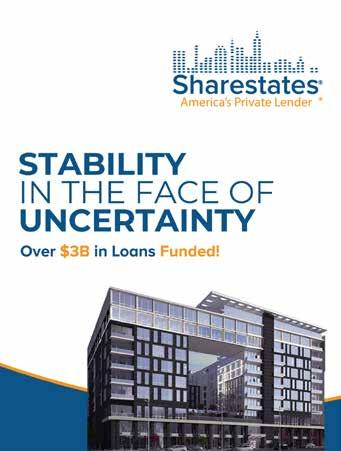
84 PRIVATE LENDER BY AAPL
LEADING THE INDUSTRY IN CONSTRUCTION RISK MANAGEMENT » Rapid Inspection Services » Streamlined Feasibility Studies » End-to-End Fund Control » Escrow Fund Management » 50 State Inspections + D.C. and PR » Construction Title Services For more information, call 833-960-8999 Request a Proposal at GraniteRiskManagement.com Residential & Commercial $50 Billion+ in Managed Services OPERATIONS

Timing Issues. Often, a borrower will need additional time to complete a project and execute their exit strategy. This can include selling the property, refinancing it into a long-term loan, such as a DSCR product, or obtaining short-term bridge financing.
A lender must communicate with the borrower throughout the process, reminding them of loan terms and timeframe. Send reminder letters with extension options at 90, 60, and 30 days before loan maturity. Understanding why the borrower needs an extension is helpful, as it allows the servicing team to guide and educate the borrower on their options. Often, it is as simple as slight construction delays, while other times, it can be more nefarious, such as a significant change (or mismanagement) of a budget, extreme permitting issues, fraud, personal issues or damage, or substantial changes to the real estate market.
A lender’s in-house servicing team must communicate and document issues regularly to avoid “surprise” scenarios.
Fraud. Unfortunately, private lenders can fall prey to fraudulent activity like any other business. False inspection reports,
title issues, wire fraud, and various other schemes are prevalent in today’s complex lending environment. Knowing what to look for and asking the right questions is vital to preventing fraud.
In the self-servicing model, the lender’s team must be vigilant to protect the firm’s assets. Question everything; dig deeper and ask more questions if something seems off. Start with the basics from day one. Is the title correct, and is the title company correctly verified and insured? Are your inspectors reputable and non-biased, and do they carry the proper insurance coverage?
A lender must review every inspection report in detail. Compare the current inspection report to the original inspection and appraisal reports. Look at every angle inside and out. Is the street address visible, and does the surrounding area look correct (especially in a ground-up)? Use simple tools such as Google Maps to validate and ensure the inspection report is the correct property. Call the inspector and the borrower to validate and question if inspection pictures and notes are vague and lack detail. Never release draw funds without
proper documentation. Your servicing team must have appropriate policies and procedures with multiple review steps to protect and prevent fraud.
Defaults. At any time, a lender will undoubtedly have to deal with borrower payment issues. Late payments, defaults, maturity without extension, and, ultimately, foreclosure are things that all lenders will encounter at one time or another. In a self-servicing model, lenders must be meticulous in their documentation and communication process. Lenders must meet internally regularly to discuss problem loans and determine the correct action. Servicing loans in-house allows a lender to develop stronger relationships with a borrower, which often affords a better understanding of the why of a default.
Developing a standard schedule of default notices and carefully documenting and tracking borrower issues is crucial. When a loan goes bad, a lender must have internal asset management resources and loss mitigation policies. Ensure all guarantors on loans know their financial liability when payments are not made and the potential impacts.
SPRING 2024 85
“
ONE CAN ARGUE THAT LOAN SERVICING IS THE MOST CRUCIAL, HIGH-IMPACT ASPECT OF ANY LENDING OPERATION."
To develop a plan to mitigate losses, a lender must understand why a borrower cannot (or will not) make payments. Early and frequent communication is critical to managing problem loans. When a borrower defaults, a lender must understand the terms of each loan, including differences by state. Having a network of legal representation or the resources to obtain representation promptly is essential. As the lender, understanding your rights, options, and details of the situation will help reduce and, hopefully, prevent any financial loss.
IS THE JUICE WORTH THE SQUEEZE?
Without a doubt, a self-servicing model has both pros and cons and requires a significant investment from a lender. Given that, a lender must determine which model is correct for their business from a financial, quantitative, and qualitative relationship standpoint.
Pros. Choosing a self-servicing model provides control over your servicing book. Keeping servicing in-house creates a heightened customer service experience; it is not uncommon for a servicing associate to know a borrower and the intimate details of their project, financial situation, and exit strategy personally.
Depending on the lender’s size, a servicing department might run lean, allowing the borrower to call in and know the
person on the other side of the line. This builds trust and confidence in a lender and ultimately fosters repeat business, significantly increasing margins.
As a lender scales, building efficiencies in the servicing technologies and processes reduces the need for excessive staffing, saving the lender from additional personnel expenses. Money saved from outsourcing costs allows the lender to reinvest in the business and scale the portfolio. Developing a deep understanding of the borrowers allows a lender to act quickly and provide innovative solutions to avert financial loss.
Cons. Human capital is expensive, and maintaining and retaining top talent can be challenging for any organization. Investing in the technology and policies infrastructure is costly, both upfront and ongoing.
A lender must carefully weigh these costs to decide whether to service loans in-house or outsource. Being too close to a borrower can sometimes be detrimental; removing a certain “human” element from the collections process can often benefit the lender. Outsourcing to a company that specializes in collections ensures a standardized process in collections and regulatory and compliance matters.
The costs associated with employee turnover, continued training and education, and investments in technology can be significant to a lender. The risk of not knowing every facet of the
regulatory landscape also poses a greater risk to a self-servicing lender. A lender must carefully weigh the risks and rewards with both methods and decide which method (or mix thereof) works best for their business model.
One can argue that loan servicing is the most crucial, high-impact aspect of any lending operation. A lender must carefully weigh their options and understand their business model and objectives when determining a loan servicing method. Each method carries risks, but ultimately, it comes down to customer experience, ease of use, and risk mitigation. A lender must carefully analyze financial and quality costs, determine the best and most efficient use of internal resources, and ultimately protect the bottom line.
EVAN BRODY

Evan Brody is the Controller at Rehab Financial Group, LP. Before joining RFG, he held several senior accounting and finance positions in the real estate and lending industries. He also spent significant time with a large family office in New York. Brody is responsible for all servicing and accounting functions, including tax and audit, loan servicing and draw management, budgeting, reporting, forecasting, cash management and treasury, benefits, and human resources, as well as day-to-day vendor relationships.
Brody is a member of the AICPA and is a licensed certified public accountant in both New York and Pennsylvania.

86 PRIVATE LENDER BY AAPL
OPERATIONS










12th Annual SINGLE FAMILY RENTAL FORUM (EAST)
May 20-22, 2024 Miami, FL The
to new registrations only
https://www.sfreast.com/
300+ SFR Pioneers Speaking 12+ Hours of Programmed Networking & Dedicated Exhibit Time LOEWS MIAMI BEACH 1800+ On-Site Attendees Use Discount Code AAPL For a 15% on Your Ticket! *applies
Venue

Leverage Virtual Employees for Flexibility and Efficiency
The adoption of virtual employees in private lending offers myriad benefits, including cost savings, access to a global talent pool, enhanced versatility, and improved operational productivity.
ANTHONY F. GERACI, MOVE

You are growing your lending business by raising capital, finding and funding good deals, and servicing both your borrowers and investors. Maybe you’re a broker, finding good deals and sending them to lenders. Either way, you need to hire a staff to help you make loans. That staff does not have to be onsite occupying office space, however, to help
you move your business forward. More and more industries, including private lending, are reaping the benefits of virtual employees—professionals who perform their job functions outside of a traditional office environment.
UNDERSTANDING VIRTUAL EMPLOYEES IN PRIVATE LENDING
In the context of private lending, virtual employees can undertake a
wide range of tasks. As a private lender, here are some key ones to consider:
Loan Processing. You can offload your loan processing to a virtual employee. Loan documents are mostly scanned in (or can be!), so this would be a perfect opportunity for a virtual employee to complete the underwriting process and monitor compliance.
Underwriting. Virtual employees are perfect for underwriting your loans.
88 PRIVATE LENDER BY AAPL
OPERATIONS
Either you have an underwriting manual or they can interview you and write one. From there, they can underwrite your loans according to your specifications.
Loan Officer Assistants. These paperwork monsters form the complement to your loan officers, allowing your loan officers to sell while their assistants chase down the needed paperwork to give to your underwriters.
Your entire back office, basically. You can also hire virtual employees for a variety of back-office needs, including accounting, accounts payable, accounts receivable, data entry, receptionist, and many other positions.
The key advantage of virtual employees is their ability to provide flexible, scalable, and cost-effective labor solutions.
BENEFITS OF USING VIRTUAL EMPLOYEES
Cost Efficiency. One of the most compelling benefits of employing virtual staff is the significant reduction in operational costs. Virtual employees eliminate the need for physical office space, utility expenses, and other overhead costs associated with maintaining a traditional office environment. Additionally, the ability to tap into a global talent pool often allows for more competitive salary structures, further reducing labor costs.
Access to a Global Talent Pool. Virtual employment breaks down geographical barriers, enabling private lenders to access a vast pool of skilled professionals from around the world. This global reach allows for the recruitment of top talent with specialized skills and expertise in private lending practices, regulatory compliance, and financial analysis, among others.
Enhanced Flexibility and Scalability. The virtual employment model offers
unparalleled flexibility, allowing private lenders to quickly scale their workforce up or down based on business needs. This agility is particularly beneficial in the private lending sector, where market demands can fluctuate rapidly. Virtual employees can be engaged on a project basis, part-time, or fulltime, providing lenders with the ability to adapt their staffing levels to current operational requirements.
Improved Operational Efficiency. Virtual employees can contribute to enhanced operational efficiency through the adoption of advanced technology and automation tools. Remote work environments often necessitate the use of cutting-edge software and systems for communication, project management, and data analysis, which can streamline processes and improve productivity.
IMPLEMENTING A VIRTUAL EMPLOYEE STRATEGY
Identify Suitable Roles. The first step in implementing a virtual employee strategy is to identify roles within the private lending operation that can be effectively performed remotely. Administrative tasks, customer support, loan processing, underwriting, and compliance are among the functions that can be easily transitioned to a virtual setting.
Leverage Technology. Successful integration of virtual employees requires robust technological infrastructure. Key components include secure cloud-based systems for data storage and sharing, communication tools such as video conferencing (Teams, Zoom) and instant messaging (Teams, Slack), and project management software (Monday, Trello, Asana, etc.) to track tasks and deadlines.
Establish Clear Policies and Procedures. Clear policies and procedures are essential for managing a virtual workforce effectively. These should cover aspects such as work hours, communication protocols, data security measures, and performance evaluation criteria. Establishing a comprehensive onboarding process is also crucial to ensure that virtual employees understand their roles, responsibilities, and the tools at their disposal.
Foster Communication and Collaboration. Maintaining open lines of communication and fostering a collaborative work environment are critical for the success of a virtual team. Regular team meetings, one-on-one check-ins, and the use of collaborative platforms can help keep virtual employees engaged and aligned with the company’s goals and objectives.
BEST PRACTICES FOR MAXIMIZING THE POTENTIAL OF VIRTUAL EMPLOYEES
Invest in Training and Development. Investing in the ongoing training and professional development of virtual employees is vital to keeping them updated on industry trends, regulatory changes, and new technologies. Doing so not only enhances their performance but also contributes to job satisfaction and retention.
Cultivate a Strong Company Culture. Creating a strong company culture and belonging can be challenging with a virtual workforce. Implementing virtual team-building activities, recognizing achievements, and encouraging social interaction can help bridge the gap and foster a positive work environment.
Monitor Performance and Provide Feedback. Regularly monitoring performance and providing constructive
SPRING 2024 89
“ THE FIRST STEP IN IMPLEMENTING A VIRTUAL EMPLOYEE STRATEGY IS TO IDENTIFY ROLES WITHIN THE PRIVATE LENDING OPERATION THAT CAN BE EFFECTIVELY PERFORMED REMOTELY. "
feedback are essential to ensure the effectiveness of virtual employees. Setting clear performance metrics and conducting periodic reviews can help identify areas for improvement and acknowledge accomplishments.
Ensure Compliance and Data Security. Complying with regulatory requirements and ensuring data security are paramount in the private lending industry. Virtual employees should be trained in compliance standards and data protection protocols, and access to sensitive information should be strictly controlled.
A LENDING CASE STUDY AT SCALE: STEALTH FINANCIAL
Stealth Financial is a private lender that makes private loans. Because it needed to save on operational capital, Stealth turned to a virtual employee solution. They housed several departments, including accounting, loan officers, underwriting, and others. After completing a 50-page underwriting manual, the underwriting manager trained all underwriters to complete underwriting based on the files given to them.
The loan officer assistants were all trained to assist the loan officers in chasing paperwork and appointments, freeing
up loan officers to talk with potential borrowers to get them to the finish line, increasing productivity by 40%.
In addition, Stealth hired loan officer assistants to work two shifts so they could cover 16 hours, creating efficiencies at scale at the price of a single U.S. employee.
Finally, Stealth rounded out its team by placing virtual employees in all areas, including receptionist, bookkeeping, AP, quality control, data analytics, financial analyst, and web developers. Stealth said that with the virtual employee strategy, “we saved 60% off our payroll costs, creating redundancy we could never afford with U.S. employees, and we did not have to give up large parts of our company to private equity as a result.”
Stealth reported that it carries a 45% NOI on its lending business as a result of embracing virtual employees—and you can too.
DON’T THINK YOU CAN? YOUR COMPETITORS THINK THEY CAN.
If don’t think you can harness the power and cost-effectiveness of virtual employees, look around. Your competitors are, and they are delivering the same product cheaper and faster than you.
How will you compete against them?
Either you will have to automate better or you, too, will have to embrace the global virtual employee solution. You won’t be able to remain competitive in the market space if you don’t.
The adoption of virtual employees in private lending offers myriad benefits, including cost savings, access to a global talent pool, enhanced flexibility, and improved operational efficiency. By carefully implementing a virtual employee strategy and adhering to best practices, private lenders can leverage this innovative approach to gain a competitive edge in the market. As the financial industry continues to evolve, the integration of virtual employees will undoubtedly play a pivotal role in shaping the future of private lending.
ANTHONY F. GERACI

In 2023, Anthony Geraci launched Move Your Business LLC to offer businesses efficient virtual employee solutions through outsourcing. His goal is to bring clients and top-tier global talent together while simplifying the hiring journey.
Well-known for his entrepreneurial savy, Geraci also fosters expansion through strategic investments in earlystage and seed round companies.
90 PRIVATE LENDER BY AAPL
OPERATIONS







SPRING 2024 91
Comp Selection: Compliant Does Not Mean Good!
If you’re using a traditional valuation product that relies on a subjective selection of three comparables, developing a quality control process that can help you better navigate the risk is worth the investment.
RODNEY MOLLEN, RICHERVALUES

Managing risk is a critical part of private lending. In this vein, it’s important to remember that compliant does not mean good. This is especially true in the world of property valuations.
Many institutions and professionals simply look to “check the boxes” of compliance to show they’ve managed risk. In reality, however, they could be ignoring the true underlying risk of the loans they are financing. Developing the right quality control processes and finding the best valuation providers can help you better navigate this risk and protect your capital from a variety of problems that might just fall outside the “checkboxes” of compliance.
This article focuses on a central topic for property valuation: comp selection. This topic is acutely important if you find yourself ordering old-school appraisals, whose values are generated by the manual selection of three comparable properties, followed by applying any set of quantitative adjustments deemed fit by the appraiser performing the work.
According to USPAP rules and common practices, there are basic parameters for
selecting comps. There are also situations where appraisers may go outside of these parameters to select their comps. The truth remains that it’s possible to meet all USPAP guidelines when selecting comps yet still provide a set of conclusions that are, shall we say, less than accurate. Here are four common areas where we frequently uncover valuation risk concerning the comp selection and subsequent conclusion of value:
1. Distance from subject
2. Condition versus budget (for ARV) or versus inspection (for current AIV)
3. Property size and “under” adjustments
4. Vintage and architectural style/quality
Let’s take a closer look at each one.
DISTANCE FROM SUBJECT
As the old adage goes, real estate is about location, location, location. It’s understood that proximity to the subject should be an important factor when
evaluating recently sold comparables to determine property value. Proximity isn’t the only factor, however. Location can be affected by neighborhood, subdivision, school district, and more.
The best question to research first is what other sold comparables were “overlooked” or not selected when the valuation professional(s) selected the comps in the report. For example, a standalone report showing three comps from 0.78 – 1.02 miles away might look great on its own, but if there were 53 comps within 0.5 miles away, then a natural skepticism should arise. What was wrong with the 53 comps that were closer in proximity to the subject that caused the valuation professional(s) to go with the comps that were further away? Was there a valid reason for selecting outside of this closer geography?
To answer these questions, you can use simple solutions such as free sites (e.g., Zillow) to view recent, nearby sold comparables, or you can use more in-depth analysis tools like RicherValues and others.
Selecting comps further away does not automatically mean the conclusions of value are incorrect. Nevertheless, it certainly should raise a flag for a
92 PRIVATE LENDER BY AAPL
OPERATIONS

deeper review. Although it does not necessarily mean the report is wrong or risky, we do find that valuation conclusions can be questionable in more than 60% of instances (not a statistical study, just loose observations).
The first item to investigate is whether the comps further away were more representative of the subject property than the sold comps that were closer in proximity. Were they chosen due to size, vintage, lot size, style, quality, or other factors? If yes, there could be a great
justification for selecting these comps further away. However, if you’re able to identify comps equally (or more) similar to the subject property, yet at closer distances to the subject, that should be a red flag.
The second item to investigate is whether there appears to be a qualitative difference in the subject neighborhood versus the neighborhoods of the selected comps and whether other/closer sold comparables appear to be in a more comparable neighborhood to the subject property.
One easy way to evaluate this is to use Google Maps, particularly its Street View feature. Although it’s true that in some secondary/tertiary/rural locations, the street views are not always current, the Google Maps platform can provide a great qualitative view into each neighborhood. Simply look up the subject property on Google Maps and use the Google Street View to drive up and down the block for as far as you’d like to go, including neighboring streets. Then do the same thing for the selected comps, and again for other sold
SPRING 2024 93
“
THE MAIN QUESTION IS SIMPLE: DO YOU FEEL THE SELECTED COMPS ARE TRULY REPRESENTATIVE AND COMPARABLE TO THE SUBJECT PROPERTY FOR VALUATION PURPOSES?
comps you may have found that are closer in proximity to the subject property. Friendly tip: Opening multiple browser tabs can provide an easy way to keep things straight!
Finally, if the comps appear justified or OK but the neighborhoods do appear to be different in quality, then were adequate adjustments (up or down) applied to the analysis to reflect these differences?
The main question is simple: Do you feel the selected comps are truly representative and comparable to the subject property for valuation purposes?
Condition Versus Budget (or Inspection)
Another critical factor at play when evaluating comp selection is property condition. Unfortunately, with traditional appraisals, you will probably only be provided with a single, exterior photo for each comparable, making it difficult to truly evaluate. Therefore, it helps to look up each comparable on a different online source in order to view more photos.
Once you have access to a complete set of photos for each comparable, you’re now in a position to ask the question: Does the condition of these selected comps reflect the “correct” condition, either as “target” condition for a post-renovation budget
(when evaluating ARV) or the current as-is condition when evaluating AIV? For more on this, take a look at the Q4 Edition of the AAPL’s Private Lender magazine, where you’ll find an entire article about identifying the correct condition/quality level when evaluating comps for ARV.
Property Size and “Under” Adjustments
This one is interesting and, unfortunately, we encounter it more often than you might think. The issue is simple.
Property size is typically a major value driver for residential real estate; the larger the property, the higher the value (usually). Therefore, when comps are selected that are smaller or larger than the subject property, an appraisal would typically apply an adjustment for the difference in size to help arrive at a comparable sales price for the subject. Interestingly, for compliance watchdogs and common quality control practices, setting large adjustments to comp sales prices can raise red flags; however, setting small adjustments will typically go unnoticed. Why? There’s typically no easy way to flag adjustments that are too small. This is exactly the scenario where you can uncover real risk hidden within deals and outside reports.
If you notice the comps selected are larger than the subject property, then ask whether the adjustments applied to these comps appear reasonable and adequate to account for the difference in size. For example, if you have a subject property that is 2,600 square feet and a comp was used in the analysis at 4,200 square feet, and only a negative $10,000 adjustment was applied in a market of properties worth $200 to $400 a square foot, then doesn’t this measly $10,000 downtick seem strange?
It should! Whether intentional or unintentional, this should be a red flag because it’s an indication the property’s value is being overestimated by comparing it to superior/larger properties, without making the proper downward adjustments to value to account for these material differences.
Whether you have access to some great analytical tools or use some good old-fashioned common sense, going through this quality control check will help mitigate your risk by making sure the value conclusions are not being disproportionately skewed due to the selection of comps and the adjustments applied (or not applied) to these comps.
Vintage and Architectural Style/Quality
Property vintage and/or architectural style/quality is another factor that typically drives value in most markets. Like property size, it’s important to spend some time investigating it.
To truly evaluate this, it’s best to find access to a full photo set for each comparable in the analysis. Once you have that, scan through the exterior and interior photos of each comparable property. Also investigate landscaping and curb appeal. Then compare those
94 PRIVATE LENDER BY AAPL
OPERATIONS
to the inspection photos (For more on that, please read our article in the Q1 2024 edition of Private Lender).
Once you have a good visual on each of the comps and the subject property, you should be in a position to determine whether you think these are strong, adequate reflections of potential value for the subject property or whether they represent a different value proposition to prospective homebuyers in that market.
Selecting properties of different vintage or architectural style/quality is not necessarily a bad thing, but if the difference is material, then you need to make sure the proper










adjustments are applied to the sales price(s) of the comps.
These are just a few common examples of risk. Many more exist. If you’re using a traditional valuation product that relies on a subjective selection of three comparables, take note! It’s important to put in the effort to obtain better information. You will greatly benefit from developing the right quality control processes and finding the best valuation providers who can help you better navigate this risk and protect your capital from a variety of problems that might just fall outside the “checkboxes” of compliance.
RODNEY MOLLEN



SPRING 2024 95
Rodney Mollen is the founder and CEO of RicherValues, a software and valuation services provider that delivers high-quality, comprehensive intelligence for lenders and investors on any residential asset nationwide. Mollen has more than 20 years of experience, including acquiring, managing, renovating, and selling over $1.2 billion in REO and NPLs nationwide from 2008-2013 as COO of an Arizona-based investment firm.
Mollen earned masters and bachelor’s degrees in economics from UCLA.
LIQUIDITY SOLUTIONS FOR PRIVATE LENDERS Fidelis Investors is a dedicated strategic capital partner for private money lenders throughout the United States. Our platform helps lenders, like you, raise capital by e ciently selling loans. Since 2009, the Residential Investment Team has successfully transacted in over $3.0 billion of whole loan purchases. Institutional Note Buyer Common Sense Purchase Guidelines Long Term Strategic Partner Fidelis Investors LLC 25 Commerce Dr, Suite 330 Cranford, NJ, 07016 info@fidelis-investors.com 908-402-8132 www.fidelis-investors.com
VENDOR GUIDE
If you’re looking for a service provider who has real experience working with private lenders, the Private Lender Vendor Guide is your starting point.
In each issue, we publish a cross section of specialties. These providers do not pay for inclusion. Instead, we vet them by reviewing their product offerings and talking to private lender references.
AAPL members can access all vendors online at aaplonline.com/vendors.

Appraisers & Valuations
Capital Providers
Data
Environmental Services
Lead Generation
Note Buying/Selling

Appraisal Nation appraisalnation.com
(866) 735-0901
Products & Services: Residential and commercial appraisals, conventional products, desktop appraisals, desk reviews, re-certs of value/draw Inspections, BPO interior/BPO exterior, commercial BPO, rental portfolios, as is + ARV, ARV only, hybrid appraisals, flood certs.

Bernhardt Appraisal
portlandresidentialappraisal.com
(971) 288-1328
Products & Services: Divorce appraisal, probate court proceedings, bankruptcy appraisal, tax/IRS appraisal, property tax appraisal, estate planning appraisal, date of death appraisal, planning for purchase, FSBO.
Brokers
Funds Control
Investor Reporting
Loan Origination Services
Loan Servicing
Loan Underwriting

Boxwood Means, LLC
BoxwoodMeans.com
(203) 653-4100
Products & Services: Reliable, on-time, and costeffective commercial evaluations; restricted appraisals, and property and environmental inspections for most CRE property types nationwide.

PCV Murcor
Secondary Specialty: Default & Loss Mitigation
pcvmurcor.com
(855) 819-2828
Products & Services: Appraisal management, BPOs and alternative valuation management for residential and commercial, disaster inspections, asset management and disposition, title and settlement services, risk exposure.

RicherValues
richervalues.com
(480) 296-6554
Products & Services: Providing institutional-grade valuations and condition-based analytics with a 3–5day turnaround on our full interior reports. Our unique, comprehensive reports provide our clients with a major advantage and differentiation in the marketplace to deliver faster closing times and improve their risk mitigation at the same time. A true, new gold standard in valuations!
CAPITAL PROVIDERS

Rice Park Capital
riceparkcapital.com
(847) 567-6600
Products & Services: We are a private equity firm that specializes in the mortgage industry. We are investing equity in and buying top private lenders.
96 PRIVATE LENDER BY AAPL
WINTER SPRING THIS ISSUE! FALL Accounting
SUMMER Development Cost Estimates
Fund Administration Insurance
Business Consultants Default & Loss Mitigation Legal Services Warehouse Lenders
Education
Marketing
VENDOR GUIDE
Recruitment & Headhunting
APPRAISERS & VALUATIONS
APPRAISERS & VALUATIONS
APPRAISERS & VALUATIONS
APPRAISERS & VALUATIONS (CONT.)
APPRAISERS & VALUATIONS (CONT.)
Investor Funding Network
investorfunding.org
(630) 640-9060
Vista Capital vista-capital.net
(760) 779-8900
ProDeal
prodeal360.com
(646) 387-4047
Zelman & Associates zelmanassociates.com

Western Technologies Group, LLC
westerntechnologiesgroup.com
(908) 725-1143
Products & Services: Flood determination services, elevation certificates, and LOMA filing with FEMA for private lenders.

InvesTechs
Secondary Specialties: Marketing investechs.com
(503) 539-8014
Products & Services: Reach the right investors with the power of technology. Accredited investor lead generation to keep your calendar full of calls with interested investors.

Private Lender Link
privatelenderlink.com

Lender Consulting Services (LCS, Inc.)
Secondary Specialties: Appraiser and valuations, environmental services, funds control, loan origination services
lenderconsulting.com
(980) 579-1041
Products & Services: Commercial and residential evaluations, appraisal reviews, appraisal validation reports, environmental Ph I/Ph II, desktops and reviews, construction monitoring/ draws, property condition reports, plan, specification and cost reviews, peer reviews.
(650) 226-4277
Products & Services: Private lender directory for companies offering short-term financing secured by residential and commercial real estate.

Scotsman Guide
scotsmanguide.com
(800) 297-6061
Products & Services: Ranked mortgage originators and lenders for residential lending (prime mortgage, FHA, USDA, & VA; non-QM; hard money; construction), commercial lending (prime commercial, multifamily property, hard money, construction), mortgage banking (correspondent line, warehouse line).
CIX
cix.com
(888) 249-1112
REI Network LP
www.myhousedeals.com
(713) 701-5144
NOTE BUYER/SELLER

Reimenn Capital Group, LLC
Secondary Specialties: Capital Provider
Reimenn.com
(713) 425-9413
Products & Services: Buyers of first position NPLs and REOs for reverse mortgages, non-QM, bridge, non-owner occupied residential, and commercial notes. Capital provider for long-term rental, shortterm rental, fix and flip, and other private loans.
Montvale, LLC
montvale.co
(302) 526-0200
If you are an industry vendor, nominate your company for this guide here:

SPRING 2024 97 Indicates AAPL Membership
DATA
CAPITAL PROVIDERS (CONT.)
ENVIRONMENTAL SERVICES
ENVIRONMENTAL SERVICES (CONT.) LEAD GENERATION LEAD GENERATION (CONT.)


As I look look back on how Sekady came to fruition, I realize t here were many surprises and unknowns.
But one thing is certain: It was born out of necessity.
I had recently sold a successful invoice factoring company and had planned to take the next few years to raise my three young teenagers. The housing market was booming and for several years, I had loaned money to a handful of local builders. My husband had a small but successful residential building company, and after I sold my factoring company, he asked me to help him with the paperwork and money movement side of his business. With my experience in invoice factoring, I understood the No. 1 rule in lending: Secure the asset. As I switched my focus from factoring to construction lending, I realized the lending I had been doing all along was not secure. I had been receiving a draw package from a general contractor, writing them a check, and assuming they were paying all their subcontractors. I
Necessity Truly Is the Mother of Invention
When we couldn't find what we needed off the shelf, we developed it ourselves!
DIANA LUOMA
understood the concept of lien waivers but not their importance until I was asked to sign an indemnity agreement at the title company. At that moment, I realized I was doing unsecured lending.
Not only was the lending unsecured, but the paperwork process in the construction space was highly inefficient. Money moved with paper checks, and chasing down lien waivers was a painful process. Subcontractors wouldn’t bill for six months and sometimes sent duplicate invoices weeks apart. Most of the documentation was still managed with actual paper. The 1099 process at the end of the year was the icing on the cake! I knew if I was experiencing these problems, others had to be experiencing them as well.
I searched for a software solution that could help me secure my money and make handling the paperwork more efficient. When I couldn’t find anything to meet my needs, I asked my small team of software developers to build something that would help me manage my husband’s projects and my growing lending portfolio.
The first iteration of Sekady was simply a digital lien waiver feature that allowed me to electronically capture a signature and make a digital payment. Subcontractors loved the process because they didn’t have to use their lunch break to sign a lien waiver or go deposit a check. Then we added features to make the building process more efficient for the general contractor. When general contractors started asking me if they could use the Sekady platform even if I wasn’t the lender, I knew we had done something right and I was going back to work!
Since then, we’ve grown to over 40 employees and continue to release features to securely move money and provide visibility to all parties involved in the construction process. I no longer worry about a general contractor making their boat payment instead of paying their plumber. I know all my money is secure before it ever leaves my account. I hope to continue building and releasing new features and ways to help my fellow lenders be successful because necessity truly is the mother of invention.
98 PRIVATE LENDER BY AAPL LAST CALL

BUILD YOUR BUSINESS. FIND YOUR TEAM.
Whether you’re looking to hire or find your next professional home, our newly-launched Jobs Board can help your search.
AAPL Members may post unlimited jobs at no cost. Use our portal to take applications, or link your job to anywhere on the internet.
(There’s no AAPL account required to search or apply for jobs.)
Get started today!

aaplonline.com/jobs


XXXXXXX 2 DAYS 50+ SPEAKERS 70+ VENDORS 700+ ATTENDEES NOV. 10-11 2024 | LAS VEGAS | AAPLCONFERENCE.COM Join us for the 15th year as we bring together owner-operators, executives, and decision-makers for the industry’s premier education and networking conference. AAPL Certification Courses | VIP Nightclub Reception Networking Breakfasts | 15+ Sessions & Panels | Private Lender Roundtables Packed Vendor Hall | Networking Reception | After Party












































































































































































